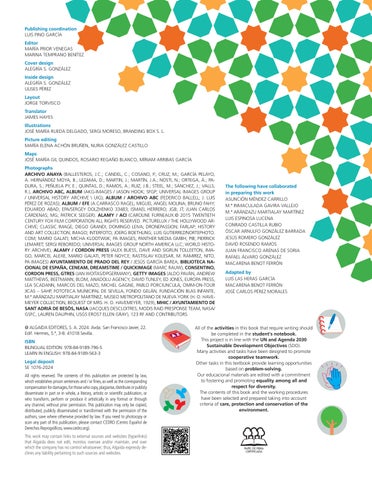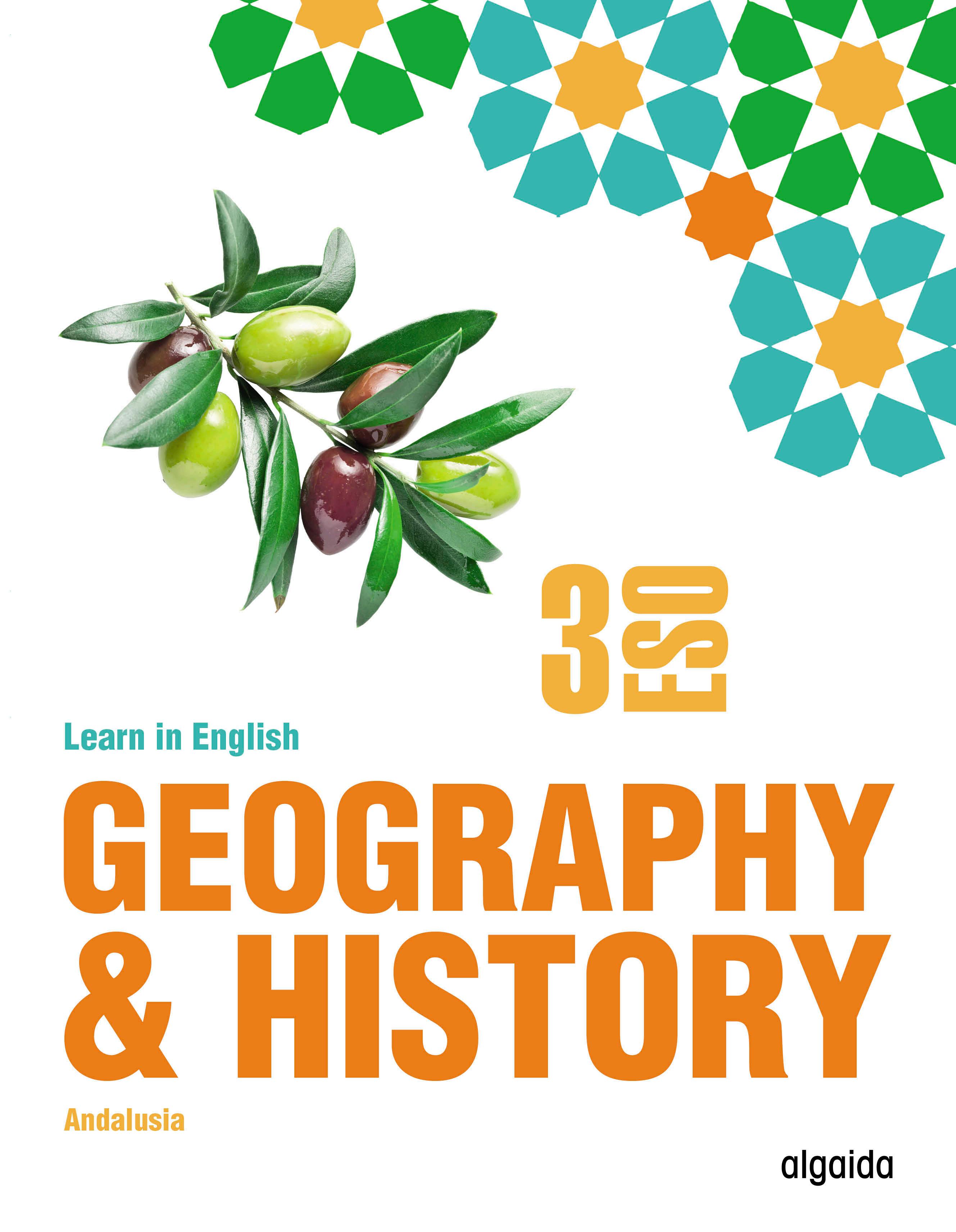
Publishing coordination
LUIS PINO GARCÍA
Editor
MARÍA PRIOR VENEGAS
MARINA TEMPRANO BENÍTEZ
Cover design
ALEGRÍA S. GONZÁLEZ
Inside design
ALEGRÍA S. GONZÁLEZ
ULISES PÉREZ
Layout
JORGE TORVISCO
Translator
JAMES HAYES
Illustrations
JOSÉ MARÍA RUEDA DELGADO, SERGI MORESO, BRANDING BOX S. L.
Picture editing
MARÍA ELENA ACHÓN BRUÑEN, NURIA GONZÁLEZ CASTILLO
Maps
JOSÉ MARÍA GIL QUINDOS, ROSARIO REGAÑO BLANCO, MÍRIAM ARRIBAS GARCÍA
Photographs
ARCHIVO ANAYA (BALLESTEROS, J.C.; CANDEL, C.; COSANO, P.; CRUZ, M.; GARCÍA PELAYO, A. HERNÁNDEZ MOYA, B.; LEZAMA, D.; MARTIN, J.; MARTÍN, J.A.; NOSTI, N.; ORTEGA, Á.; PADURA, S.; PEÑUELA PY, E.; QUINTAS, D.; RAMOS, A.; RUIZ, J.B.; STEEL, M.; SÁNCHEZ, J.; VALLS, R.), ARCHIVO ABC, ALBUM (AKG-IMAGES / JASON HOOK; SFGP; UNIVERSAL IMAGES GROUP / UNIVERSAL HISTORY ARCHIVE \ UIG); ALBUM / ARCHIVO ABC (FEDERICO BALLELL; J. LUIS PÉREZ DE ROZAS); ALBUM / EFE (A.CARRASCO RAGEL; MIGUEL ANGEL MOLINA; BRUNO FAHY; EDUARDO ABAD; EPA/SERGEY DOLZHENKO 33483; ISMAEL HERRERO; JGB; JT; JUAN CARLOS CÁRDENAS; MG; PATRICK SEEGER). ALAMY / ACI (CAROLINE FURNEAUX.© 2015 TWENTIETH CENTURY FOX FILM CORPORATION ALL RIGHTS RESERVED. PICTURELUX / THE HOLLYWOOD ARCHIVE; CLASSIC IMAGE; DIEGO GRANDI; DOMINGO LEIVA; DRONEPASSION; FARLAP; HISTORY AND ART COLLECTION; IMAGO; INTERFOTO; JOERG BOETHLING; LUIS GUTIERREZ/NORTEPHOTO. COM; MARIO GALATI; MICHA KLOOTWIJK; PA IMAGES; PANTHER MEDIA GMBH; PIB; PIERRICK LEMARET; SERGI REBOREDO; UNIVERSAL IMAGES GROUP NORTH AMERICA LLC; WORLD HISTORY ARCHIVE), ALAMY / CORDON PRESS (ALEX BUESS, DAVE AND SIGRUN TOLLEETON, IMAGO, MARCEL ALEXE, MARIO GALATI, PETER NOYCE; RASTISLAV KOLESAR, M. RAMIREZ, NITO, PA IMAGES) AYUNTAMIENTO DE PRADO DEL REY / JESÚS GARCÍA BAREA, BIBLIOTECA NACIONAL DE ESPAÑA, CENEAM, DREAMSTIME / QUICKIMAGE (MARC RAUW), CONSENTINO, CORDON PRESS, GTRES (JAN WOITAS/DPGERMANY), GETTY IMAGES (ALDO PAVÁN, ANDREW MATTHEWS, BEETMANN, BLOM, ANADOLU AGENCY, DAVID TUNLEY, ED JONES, EUROPA PRESS, LEA SCADANN, MARCOS DEL MAZO, MICHEL GAGNE, PABLO PORCIUNCULA, OMM-ON-TOUR )ICAS – SAHP, FOTOTECA MUNICIPAL DE SEVILLA, FONDO GELÁN, FUNDACIÓN BLAS INFANTE, M.ª ARÁNZAZU MARTIALAY MARTÍNEZ, MUSEO METROPOLITANO DE NUEVA YORK (H. O. HAVEMEYER COLLECTION, BEQUEST OF MRS. H. O. HAVEMEYER, 1929), MHIC / AYUNTAMIENTO DE SANT ADRIÀ DE BESÒS, NASA (JACQUES DESCLOITRES, MODIS RAID PRESPONSE TEAM, NASA/ GSFC, LAUREN DAUPHIN, USGS EROS7 ELLEN GRAY), 123 RF AND CONTRIBUTORS.
@ ALGAIDA EDITORES, S. A. 2024. Avda. San Francisco Javier, 22. Edif. Hermes, 5.ª, 3-8. 41018 Sevilla.
ISBN
BILINGUAL EDITION: 978-84-9189-796-5
LEARN IN ENGLISH: 978-84-9189-563-3
Legal deposit
SE 1076-2024
All rights reserved. The contents of this publication are protected by law, which establishes prison sentences and / or fines, as well as the corresponding compensation for damages, for those who copy, plagiarise, distribute or publicly disseminate in part or in whole, a literary, artistic or scientific publication, or who transform, perform or produce it artistically in any format or through any channel, without prior permission. This publication may only be copied, distributed, publicly disseminated or transformed with the permission of the authors, save where otherwise provided by law. If you need to photocopy or scan any part of this publication, please contact CEDRO (Centro Español de Derechos Reprográficos, www.cedro.org).
This work may contain links to external sources and websites (hyperlinks) that Algaida does not edit, monitor, oversee and/or maintain, and over which the company has no control whatsoever; thus, Algaida expressly declines any liability pertaining to such sources and websites.
The following have collaborated in preparing this work
ASUNCIÓN MÉNDEZ CARRILLO
M.ª INMACULADA GAVIRA VALLEJO
M.ª ARÁNZAZU MARTIALAY MARTÍNEZ
LUIS ESPINOSA LUCENA
CONRADO CASTILLA RUBIO
ÓSCAR ARNULFO GONZÁLEZ BARRADA
JESÚS ROMERO GONZÁLEZ
DAVID ROSENDO RAMOS
JUAN FRANCISCO ARENAS DE SORIA
RAFAEL ÁLVARO GONZÁLEZ
MACARENA BENOT FERRÓN
Adapted by
LUIS LAS HERAS GARCÍA
MACARENA BENOT FERRÓN
JOSÉ CARLOS PÉREZ MORALES
All of the activities in this book that require writing should be completed in the student's notebook. This project is in line with the UN and Agenda 2030 Sustainable Development Objectives (SDO). Many activities and tasks have been designed to promote cooperative teamwork.
Other tasks in this textbook provide learning opportunities based on problem-solving. Our educacional materials are edited with a commitment to fostering and promoting equality among all and respect for diversity.
The contents of this book and the working procedures have been selected and prepared taking into account criteria of care, protection and conservation of the environment.
PAPEL DE FIBRA CERTIFICADA

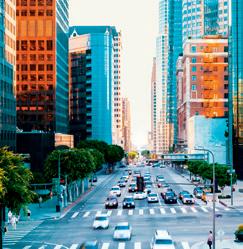


1 Demography 1. The importance of demography 8 2. The natural dynamics of population 8 3. Population and its distribution 8 Activities 9 4. Migration dynamics 10 5. Characteristics of demography in Spain and Andalusia 10 Activities 11 Activities 13 6. Present and future demographic challenges: ageing and depopulation 14 Activities and task: Population pyramids 15 Grammar in G&H: adjectives, comparatives and superlatives 16 10 questions 16 Final task: Awareness of the demographic challenge 17 2 The human space 1. Human beings in their territory 18 2. Rural settlement 18 Activities and task: Defence of rural heritage 19 3. Rural settlement in Spain and in Andalusia 20 4. The urban space 20 Activities 21 5. The urbanisation process in Spain. The Spanish urban system 22 6. The urbanisation process in Andalusia. The Andalusian urban system 22 7. Future challenges 22 Activities and task: Defending urban heritage 23 Grammar in G&H: present perfect, affirmative, negative and interrogative 24 10 questions 24 Final task: Creating a tourist information leaflet 25 3 The economic systems 1. How do we satisfy our needs? Economic activities 26 Activities 27 2. Economic systems 28 3. Colonialism, imperialism and other forms of subordination 28 Activities 29 4. How markets work in a global economy 30 5. Dilemmas and uncertainties of today’s economy 30 Activities and task: The 7Rs of the circular economy 31 Grammar in G&H: past simple 32 10 questions 32 Final task: Globalisation, a model under debate 33 4 Evolution of economic sectors 1. The primary sector 34 Activities 35 2. The secondary sector 36 Activities 37 3. The tertiary sector 38 Activities and task: Local consumption 39 Grammar in G&H: present perfect and past simple 40 10 questions 40 Final task: Produce less or less consumption? 41
Index
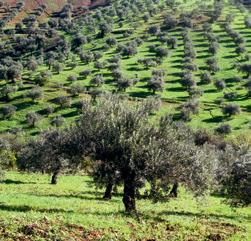
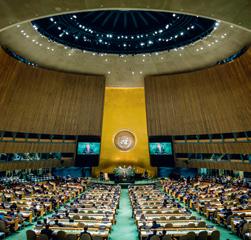

5 European, Spanish and Andalusian economy 1. The European economy in the world 42 2. The sectors of European economic activity 42 Activities 43 3. Imbalances and challenges for the European economy 44 4. Traits and characteristics of the Spanish and Andalusian economies 44 Activities and task: Draw up a family budget 45 5. The economic sectors of Spain and Andalusia 46 Activities 47 6. Future challenges for the Spanish and Andalusian economies 48 Activities 49 Grammar in G&H: past continuous 50 10 questions 50 Final task: Learn about and draw up General National Budgets 51 6 The political situation of the world today 1. Political organisation of the world 52 2. Geopolitics and globalisation 52 Activities 53 3. Violent resolution of conflicts 54 Activities 55 4. Peaceful solution to conflicts 56 5. Challenges on the global agenda 56 6. Andalusian solidarity actions 56 Activities and task: Fake news 57 Grammar in G&H: future tense 58 10 questions 58 Final task: A session in the Security Council 59 7 Environmental challenges and eco-social awareness 1. The impact of humans on the environment 60 2. Planetary boundaries 60 Activities 61 3. The climate emergency 62 Activities and task: Time-lapse as evidence 63 4. The Sustainable Development Goals 64 5. Environmental problems and SDGs in Andalusia 64 Activities 65 Grammar in G&H: talking about plans, predictions 66 10 questions 66 Final task: Preparing an interview 67
Index
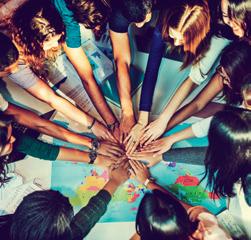

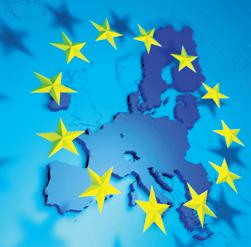
9 Regulatory system in Spain and Andalusia 1. Historical background to the Constitution of 1978 76 Activities and task: A news story 77 2. The Spanish Constitution of 1978 78 3. The state of the autonomous communities 78 Activities 79 4. The autonomous community of Andalusia 80 5. Spain and Andalusia on the international stage 80 6. Heritage and the action to conserve it 80 Activities and task: The heritage sites in my area 81 Grammar in G&H: the second conditional 82 10 questions 82 Final task: A podcast about the intangible heritage of Andalusia 83 10 The construction of the European Union 1. Europeanism: the idea of being European 84 2. The construction of the European Union 84 Activities 85 3. The symbols of the European Union 86 4. The institutions of the European Union 86 Activities and task: How do you detect a counterfeit euro banknote? 87 5. European policies 88 6. Spain and Andalusia in the EU 88 Activities 89 Grammar in G&H: the third conditional 90 Ten questions 90 Final task: A visual journey through the European Union 91
Maps 93 8 Institutions and policies for equality and social justice 1. An unequal world 68 2. Human rights as a response 68 Activities and task: The reality of refugees 69 3. Towards real equality between women and men 70 4. Towards diversity and interculturalism 70 Activities and task: The Istanbul convention 71 5. Scientific and technological progress: opportunities and risks 72 6. Andalusia in the 21st century. A diverse and multicultural community 72 Activities 73 Grammar in G&H: the first conditional 74 10 questions 74 Final task: A workshop about inequalities 75
APPENDICES:
WHAT'S IN YOUR BOOK?
Contents
The themes are located on the left pages. In the central column all content is adapted to the linguistic level. In the margins there are diagrams, maps, photographs, graphics and illustrations. The most important words are highlighted in bold.


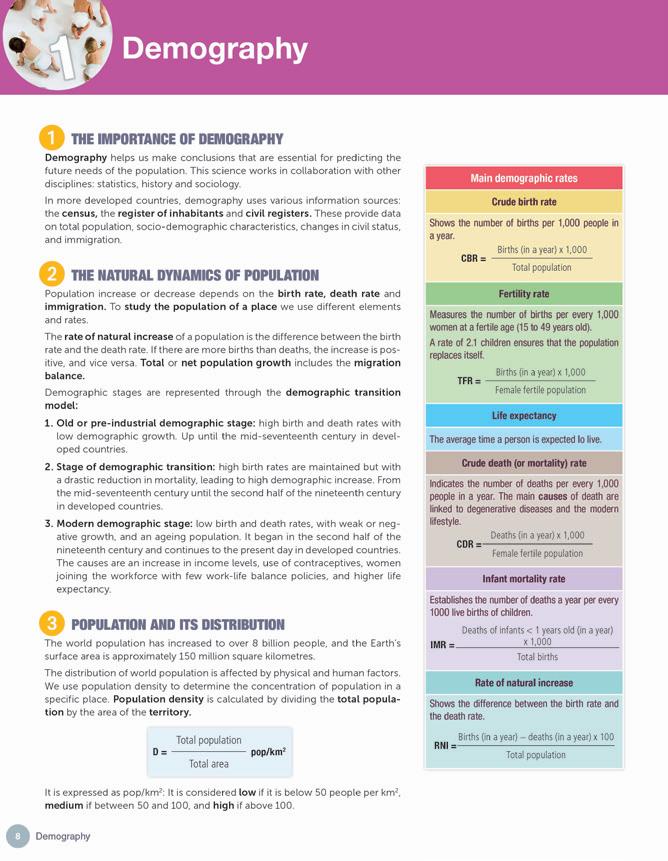
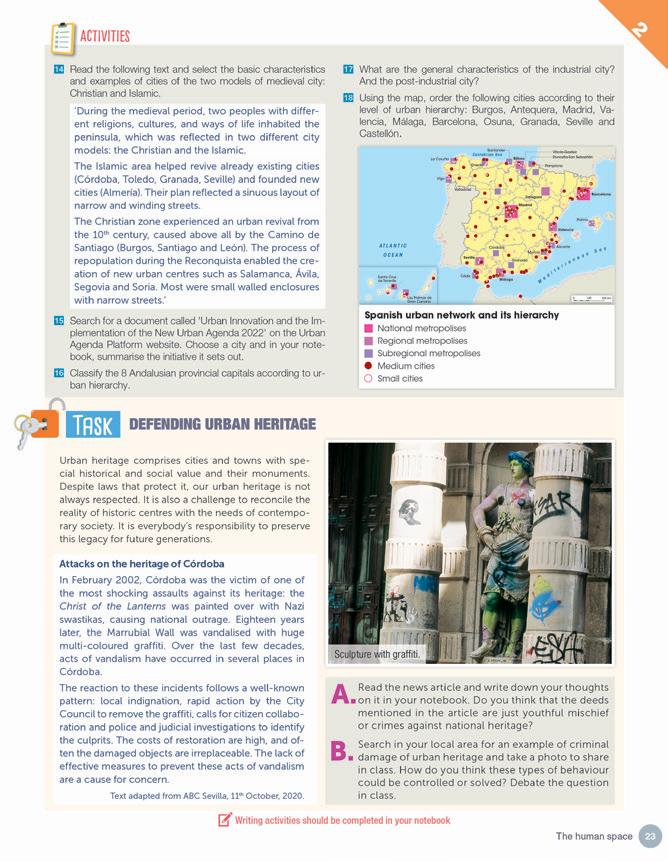
Final sections
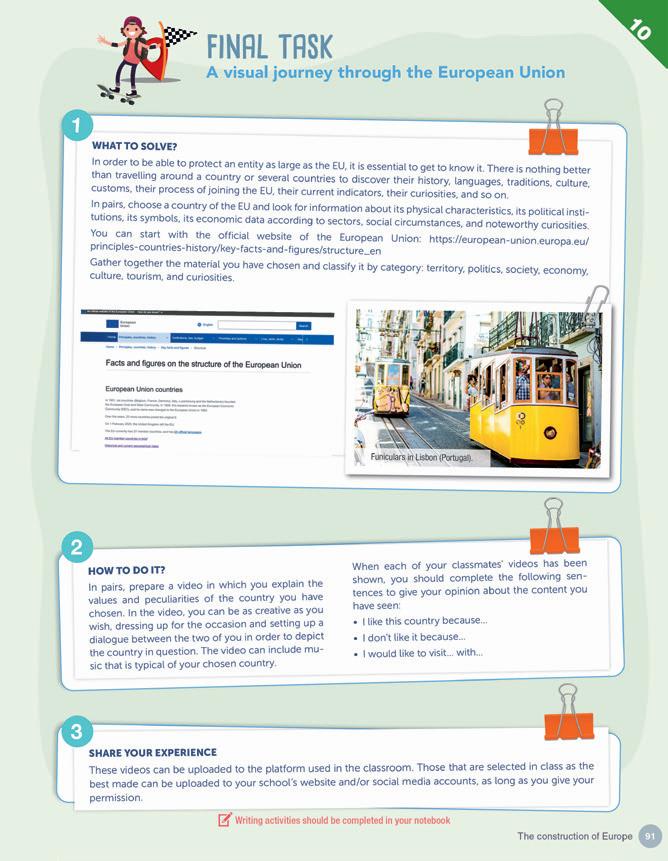

On the right pages you will find all the activities related to the themes located on the left page. The proposed activities follow the CLIL (AICLE) methodology. The five skills are worked on: reading, listening, speaking, writing and conversation. In addition, you will find different tasks, a proposal of different learning situations.
Each unit ends with three sections:
• Grammar in Geography and History: you will find a grammar rule with a proposal of activities to apply grammar to specific contents.
• 10 Questions: summary of the main ideas organised in questions and answers.
• Final task: a group of activities to apply and consolidate what you have learned.
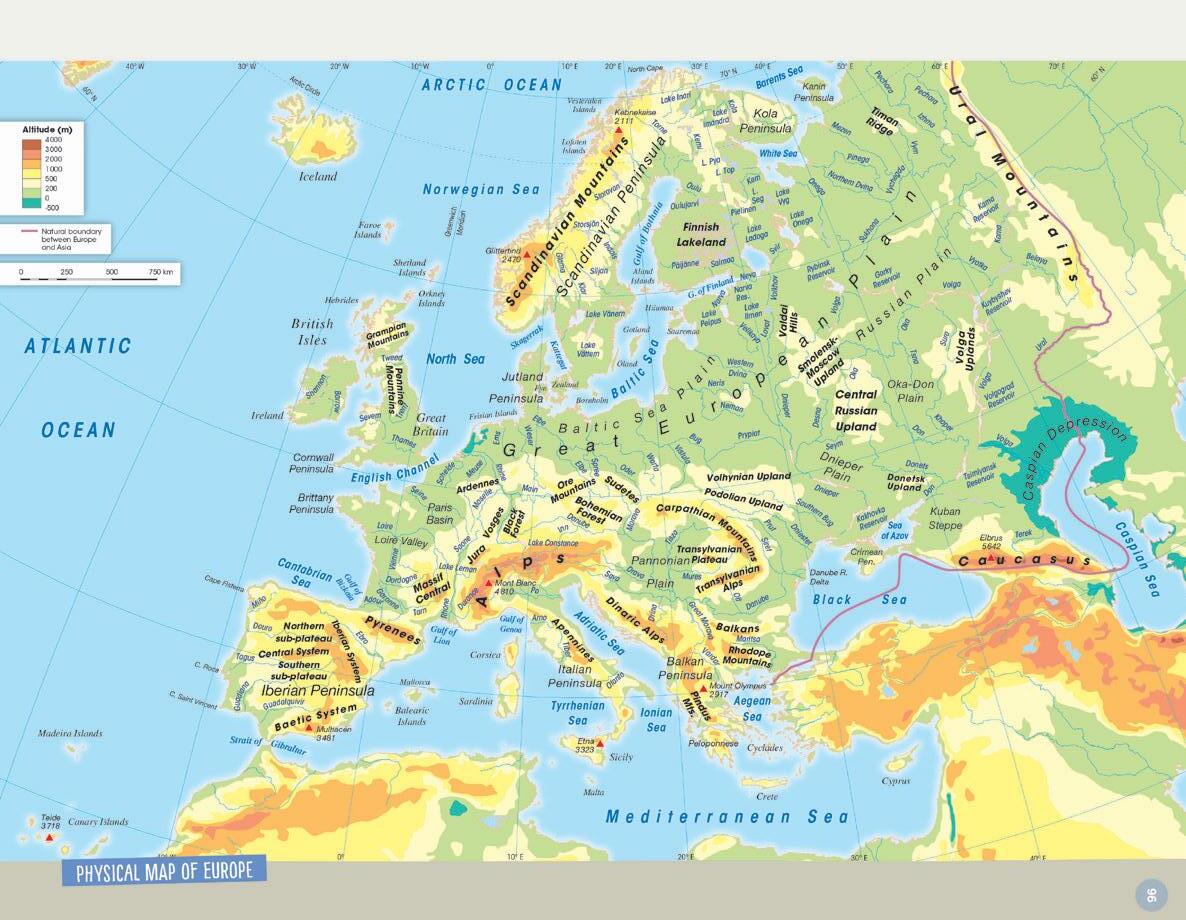
Maps
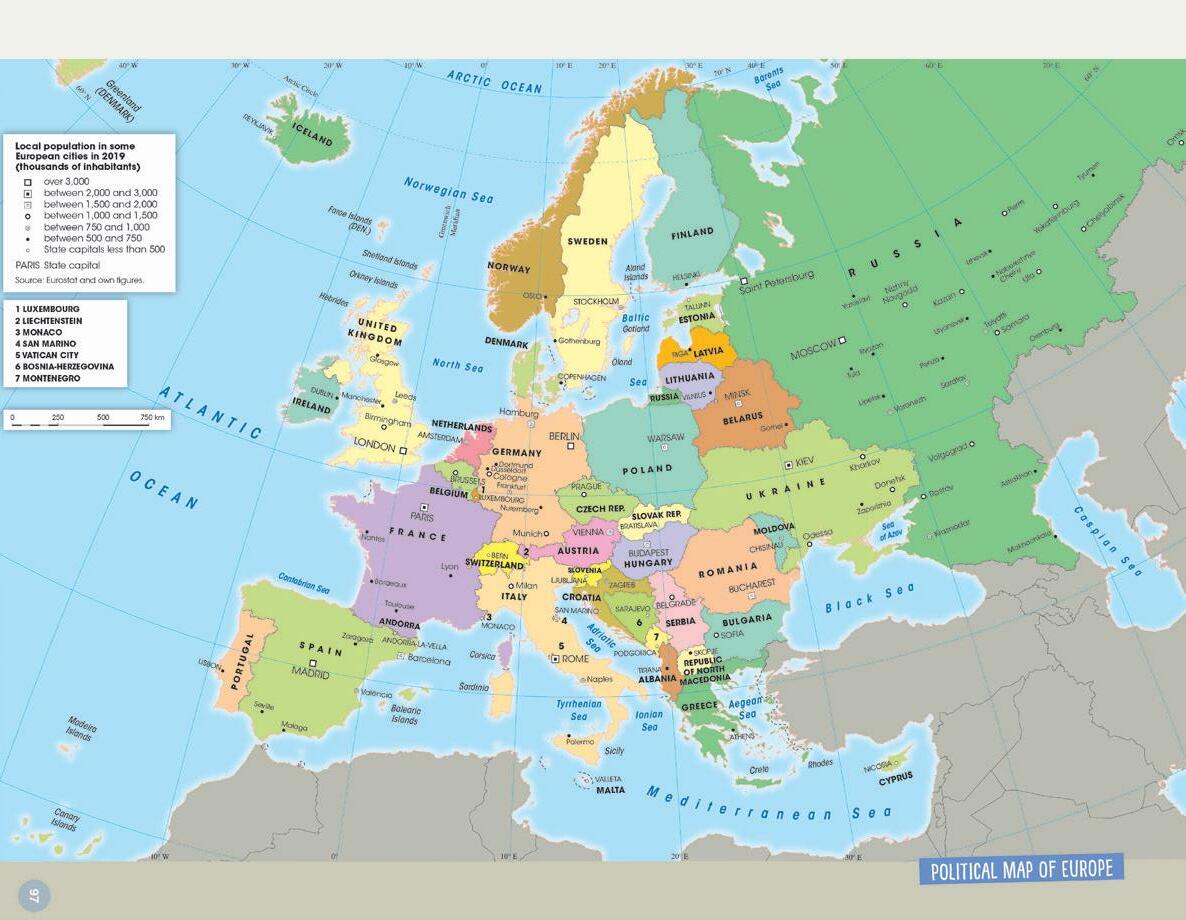
What's in your digital book?

Extra global resources
• Online dictionary
• Reference websites
• Museums
• International institutions
• Media
Digitised version of Learn in English with all the units and sections.
All the audio recordings related to the activities.
Links to online dictionaries and reference web pages.
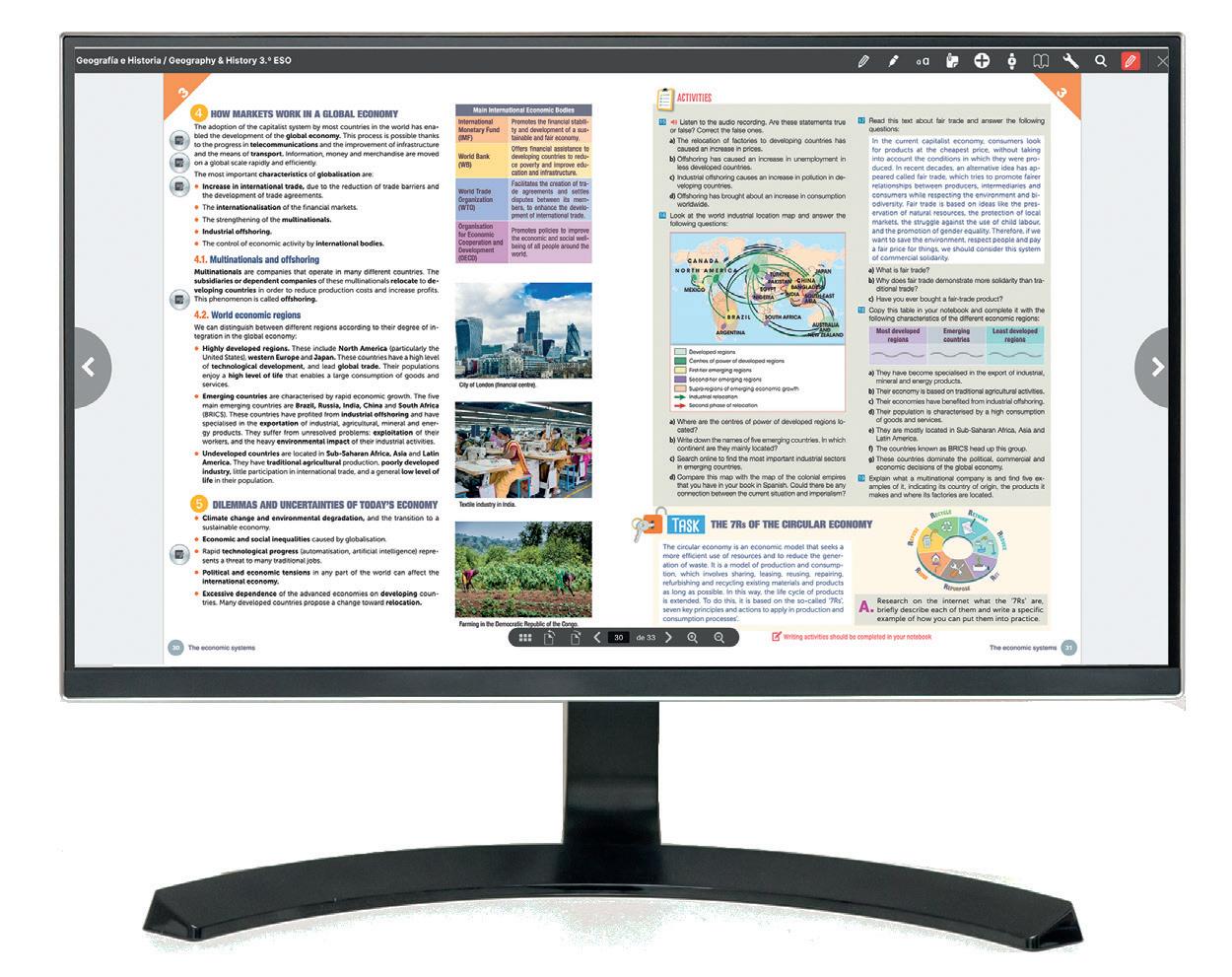
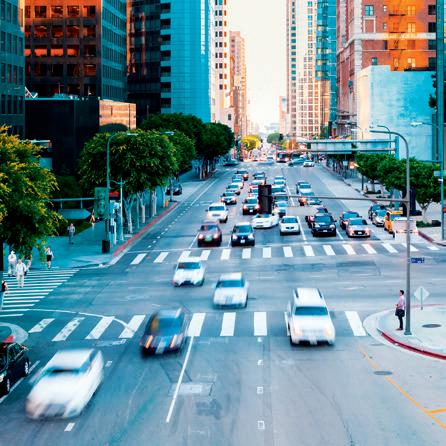
2 The human space
➊ HUMAN BEINGS IN THEIR TERRITORY
People occupy and carry out activities in geographic space on the Earth. We differentiate between:
z The natural space, which encompasses the surface that has not been altered by humans, with protective measures.
z The human space, which is modified by human activities. We can also classify the land between:
z The rural space, with low population density and associated with primary activities.
z The urban space, with high population density, concentration of housing, and a population devoted mainly to the secondary and tertiary sectors.
➋ RURAL SETTLEMENT
Settlement is the process of humans settling the territory, and we can distinguish two forms: rural and urban settlement.
2.1. Types of rural settlement
Rural settlement is found in towns, isolated homes in the countryside, or small villages. There are different types of rural settlement depending on the distribution of the population in towns.
2.2. Building and construction. The road network
In rural zones, the architecture is characterised by the use of local materials such as stone, timber and brick, using geographical orientation to face climate conditions. Horizontal construction predominates, although sometimes houses with several storeys are built with annexes such as storerooms and stables. The road network is made up of secondary and tertiary roads. These roads connect the production centres of the primary sector with the distribution centres. There are also natural routes and drovers’ roads like cattle tracks, bridleways and paths, enhancing the connection between the urban and the rural populations, and promoting interest in protecting this environment.
2.3. Economic activities and ways of life
The main economic activity in the rural environment is agriculture, employing 42 % of the population. Livestock farming and forestry industries are also important.
Today there is a growth in new activities linked to rural tourism; and the opening of processing plants of products from the primary sector, and of power plants.
Most employment is self-employment or freelance, and consists of family companies or small businesses. Many young people migrate to urban areas. There are financial assistance plans to encourage the new generation to take over. This environment offers a quiet, high-quality way of life that is in touch with nature.
Sustainable rural tourism contributes to population stability. Some villages lack basic amenities and depend on visiting mobile services for essential activities such as shopping, healthcare and education.
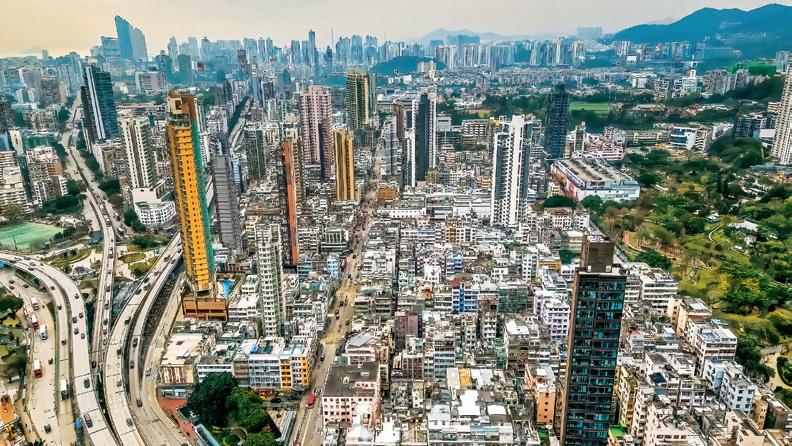

Types of rural settlement
Dispersed
The population lives in isolated houses surrounded by fields and woods.
Nucleated
The houses form small centres of population such as villages or towns.
Interspersed
Dispersed buildings around a nucleated population centre.
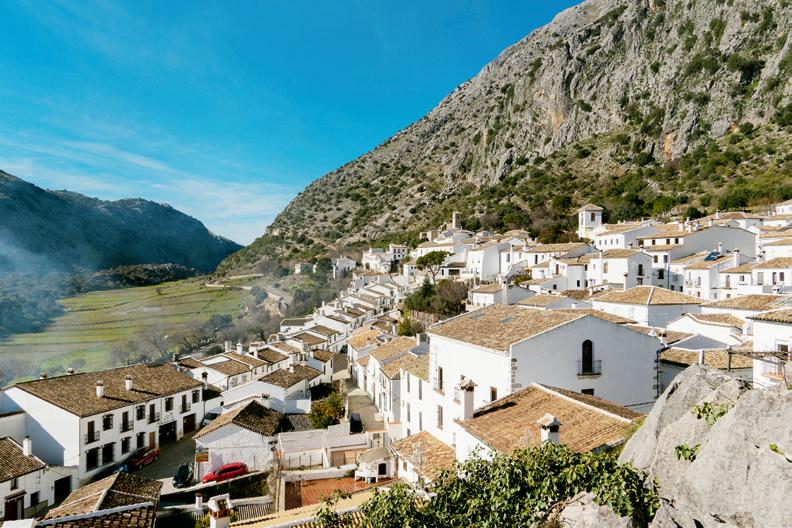
28 The human space
Tokyo, an example of urban space.
Włodowice, in Poland, an example of rural space.
Villaluenga del Rosario, a small town with low population in Cádiz. The cheese industry has tranformed the local economy.
Activities
1 Look at the following images and in your notebook write down the concept they each represent: natural space, human space, rural space, and urban space.
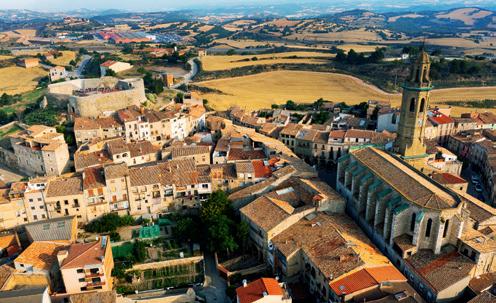
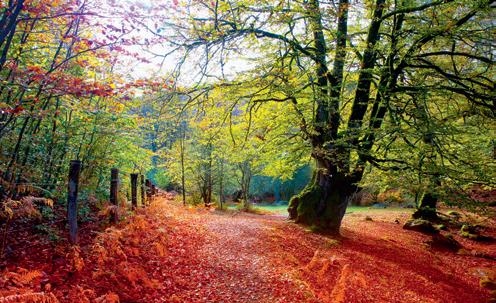
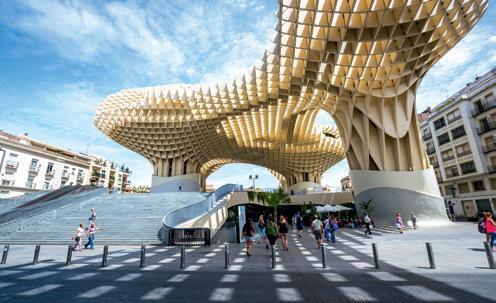

2 Match each definition with the correct term in your notebook: natural space, rural space, urban space, human space.
a) Surface unaltered by humans.
b) Space transformed by humans.
c) Space with protective measures.
d) Its population carries out primary-sector activities.
e) Area with large population concentration.
3 In your notebook, complete the sentences with the correct words.
a) When houses are arranged together forming small populations centres or towns, we are referring to
b) In the settlement, the population lives in isolated houses surrounding agricultural land.
c) A middle-sized settlement with dispersed buildings next to a concentrated population centre is called
4 2 Listen to the audio recording and answer the questions:
a) What is the average age in the population of rural areas?
b) Do women and men earn the same amount?
c) Does gender equality currently exist in the rural world?
Task DEFENCE OF RURAL HERITAGE
Looking across the world, rural communities tell us the story of a thousand-yearlong collaboration between nature and human society. In a time of constant new challenges, rural communities must grapple with matters beyond protection, but grasp the opportunities –and understand the potential– springing from their diverse and dynamic heritage.
RURITAGE turns rural areas into laboratories to demonstrate Cultural and Natural Heritage as an engine of regeneration.
Adapted source: www.ruritage.eu
5 Describe the typical characteristics of rural architecture based on the illustration:
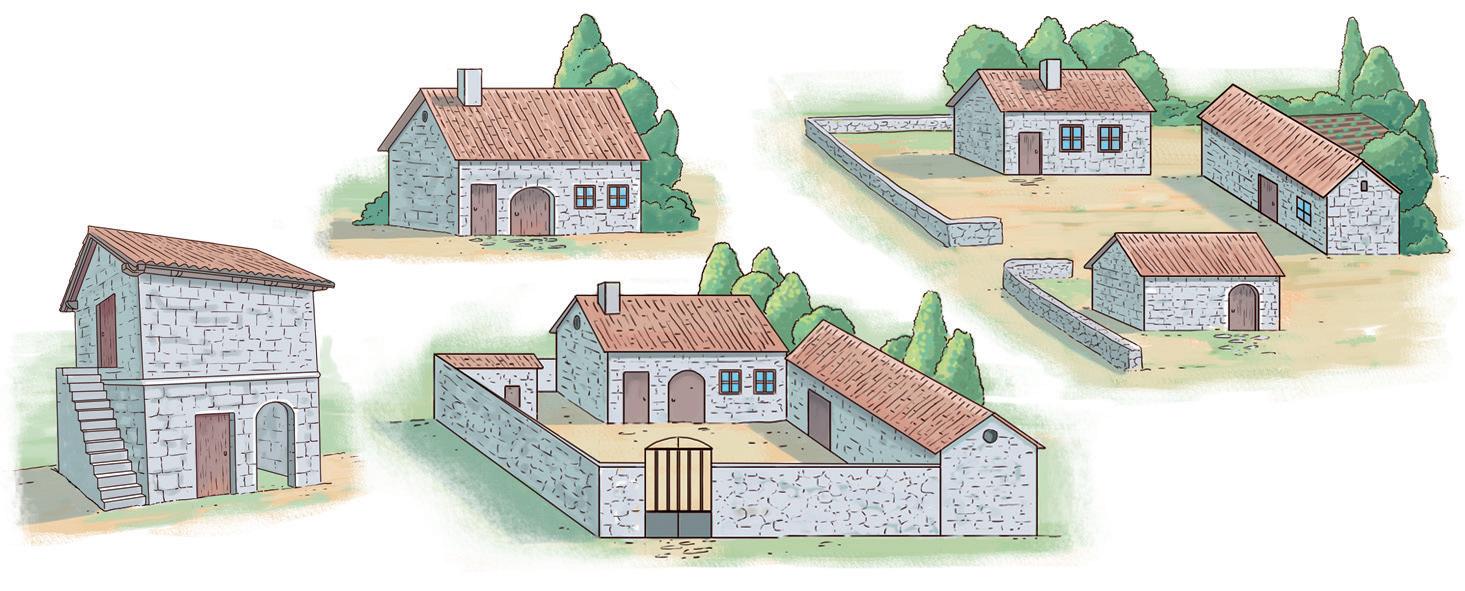
6 Are the following sentences true or false? Correct the incorrect ones in your notebook.
a) In the rural world there are only primary and secondary roads.
b) Local roads are very important because they connect the production centres of primary sector activities with distribution centres.
c) As well as provincial and local roads, in the rural world there are natural paths and drovers’ roads.
7 Complete the following table on economic activities and ways of life in rural areas.
Term Characteristics
Self-employed family companies that account for most employment.
Sustainable rural tourism
Main economic activity of the rural environment.
They lack them and are dependent for essential activities such
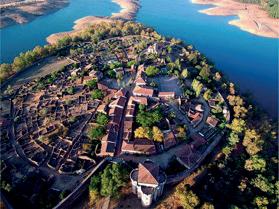
C.
heritage with the following terms: environmental education, environment, balance , customs, archaeological heritage.
29 The human space Writing activities should be completed in your notebook
2
V
b) d)
a) d) b)
a) c)
Granadilla (Cáceres). c)
➌ RURAL SETTLEMENT IN SPAIN AND IN ANDALUSIA
In Spain, the rural population comprises those who live in municipalities with fewer than 30,000 inhabitants at a density below 100 inhab./km². This population represents 17 % of the total population, around 8 million people in 6,671 municipalities.
The regions with the highest proportion of rural population are Extremadura, Castilla-La Mancha, Castile and Leon, and Aragón.
There are two factors that determine the type of settlement in a place: the physical factors (climate, relief, and soil); and the human factors (sufficient natural resources, access to communication routes, and so on).
In Andalusia there are three types of settlement:
z Dispersed. In mountainous areas and irrigated areas.
z Nucleated. In the interior.
z Interspersed. On plains with the co-existence of farmsteads and agro-cities. The main activities include agriculture, livestock industry, forestry, hunting, and rural tourism.
➍ THE URBAN SPACE
A city is an inhabited space of a particular size and density. Most cities have different functions that vary depending on their size: residential, commercial, personal services, financial or social.
Urban morphology is the external aspect of the city. It is determined by:
z The site is related to the physical setting where a city is found, such as rivers, hills or coastal areas.
z The situation refers to the location of the city in relation to a larger area.
z The urban plan represents the constructed spaces.
z The urban fabric (the way the buildings are grouped) can be irregular, concentric, orthogonal, linear or a combination of these.
z The type of construction affects the urban fabric. It can be closed or open.
z Land uses include categories such as where building is permitted, where it is not permitted, land for facilities, and green spaces.
The urban structure organises the city into different zones, including:
z The urban centre, formed by:
z The historic centre, which preserves elements from past historical periods.
z The business centre, which focuses on commercial and financial activities.
z The ensanche (urban expansion), the planned expansion of cities that took place in the 19th and 20th centuries, replacing city walls with broad avenues.
z The outskirts, coming into being in the 1950s, notable for block or tower buildings.
Urban areas are separated into residential, commercial, industrial, recreational and suburban zones, shaped by the influence of the motor vehicle and urban transport.
Urban economic activities, mainly in the secondary and tertiary sectors, attract rural migrants and immigrants, offering employment opportunities. Traditionally, the forms of urban and rural life were different, but communication technologies, gender equality, social diversity, tourism and globalisation have lessened these differences in the present day.
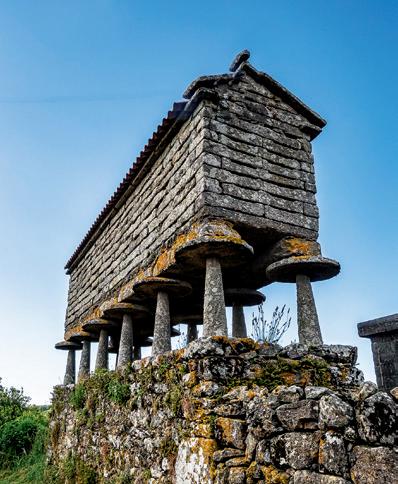
Raised granary (Hórreo), Galicia. Terrera house, Canary Islands.
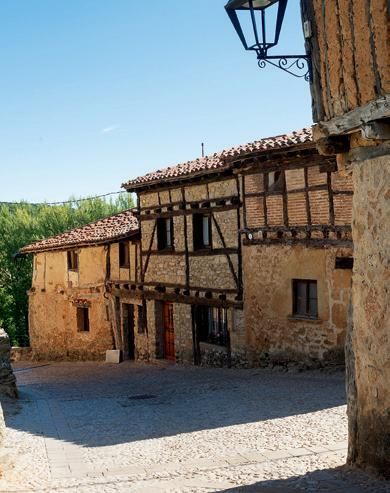
Mud-brick houses, Castile and Leon.

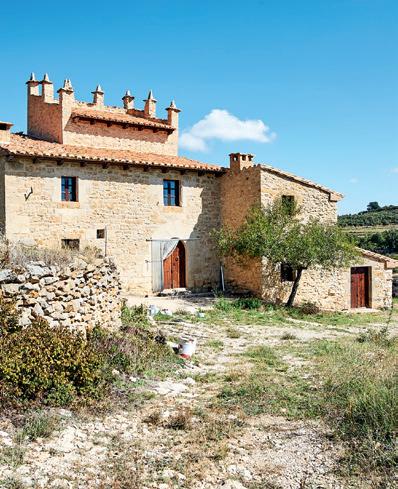
The country has a very wide range of rural architecture, both on the peninsula and on the islands: cortijos (farmsteads) in Andalusia, barracas (small farmhouses) in Valencia, mud-brick houses in Castile and Leon, terrera houses on the Canary Islands, or houses with local stone and good ventilation on the Balearic Islands.
Rural habitat in Andalusia
Cortijo
Farmstead. Large house with varied outbuildings: principal house, rooms for workers, barn.
Hacienda
Country estate. Large area of land dedicated to vineyards and olive groves.
Block house
An individual house with different levels typical of mountainous areas.
Cave houses
Houses excavated out of the slopes of gullies and hillsides.
SUSTAINABLE DEVELOPMENT GOAL 11
Make cities inclusive, safe, resilient and sustainable
One of the aims of this SDG is to ensure all people’s access to adequate, safe and affordable housing and basic services, and to improve marginal neighbourhoods.
Draw up a list of all the elements, services and characteristics that you deem necessary for achieving a city that meets SDG 11 the most.
30
human space 2
The
Country house (Catalan masía), Castellón.
Activities
8 In your notebook, match each type of housing with the area it is usually found in. If necessary, search for information on the internet.
a) Cortijo 1. Catalonia
b) Zahúrda 2. Valencian Community and Murcia
c) Hórreo 3. Castilla-La Mancha and Andalusia
d) Masía 4. La Rioja
e) Barraca 5. Balearic Islands
f) Pyrenean house 6. Extremadura
g) Guardaviña 7. Aragón
h) Terrera house 8. Canary Islands
i) Mediterranean architecture
9. North of Spain
9 In your notebook, say if these sentences are true or false.
a) One of the regions with the highest proportion of rural population is Castile and Leon.
b) Spanish rural architecture is homogeneous. There are no differences between regions.
c) In the interior of Andalusia, a type of dispersed rural settlement predominates.
d) The co-existence of cortijos and agrocities occurs in interspersed settlements.
e) Cave houses are found excavated out of the sides of gullies or hillsides.
10 Do the crossword in your notebook:
1. House with rectangular ground plan with low walls and gabled roof.
2. Isolated country houses with land for agricultural and livestock activities.
3. Buildings for storing and preserving foodstuffs protected from the damp and animals.
4. Rustic farmstead with country house and outhouses.
11 Match each term with its definition.
a) Location in the city in relation to a larger space that it organises
b) Plan in which the streets cross one another at right angles.
c) Physical area in which the city is located
d) Representation of the built-up areas and the urban fabric
e) Style in which the buildings are arranged leaving large free spaces
f) Plan that is characterised by the development of the settlement along a river or communication route
12 Write the questions for these answers.
1. Open
2. Linear
3. Orthogonal or grid
4. Situation
5. Urban plan
6. Site
a) Historic centre, ensanche and outskirts.
b) The main economic activities of urban areas correspond to the secondary and tertiary sectors.
c) Communication technologies, gender equality, social diversity, tourism and globalisation.
13

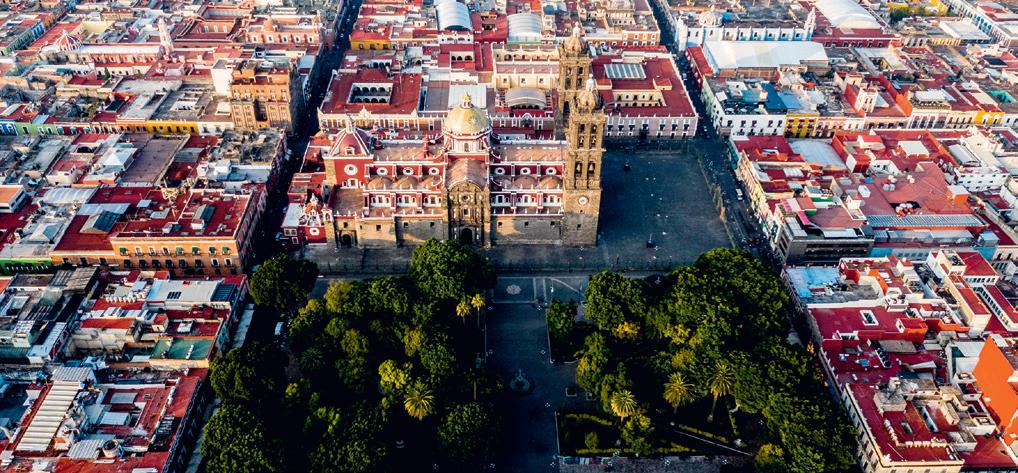
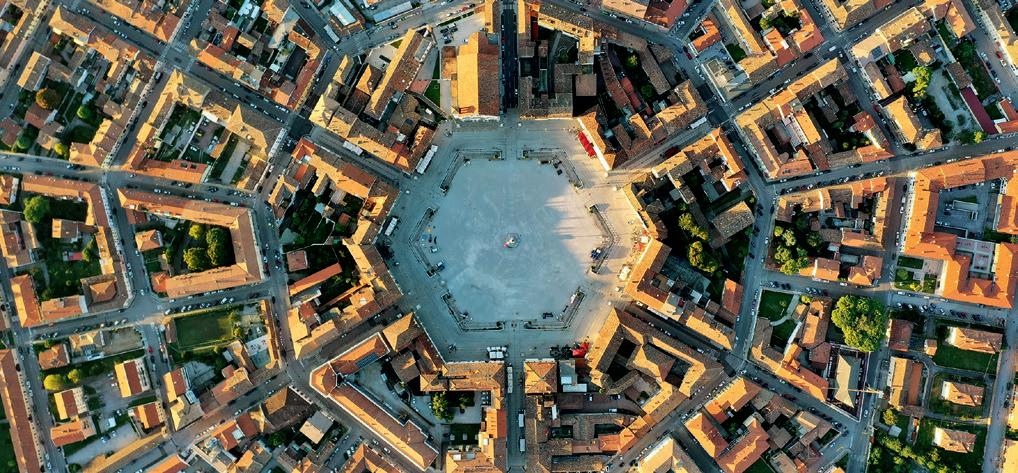
31 The human space Writing activities should be completed in your notebook V 2
4 1 2 3
a) b) c)
➎ THE URBANISATION PROCESS IN SPAIN. THE SPANISH URBAN SYSTEM
The urbanisation process is divided into three stages:
z The preindustrial city developed with influences from different cultures: Phoenician, Punic, Greek, and Roman. The co-existence of Christian and Islamic models during the Reconquista gave rise to different urban designs. In the Early-Modern Period, urban improvements, aesthetic and infrastructure reforms took place.
z The industrial city (from the mid-19th century until 1975) entailed a change in urban morphology. Internal reforms and plans of expansion were carried out to improve habitability and urban services. Rural flight brought about the creation of new neighbourhoods. In the 1950s and 1960s, shanty towns appeared due to the arrival of rural migrants and the lack of housing.
z The post-industrial city (after 1975) grew gradually. Changes in the economic model occurred, with a shift toward tertiary activities. The large cities grew slowly and diffuse urbanisation (urban sprawl) began to appear, expanding the urban outskirts.
An urban system is the set of cities of a particular territory and the set of connections that they establish between each other and their surroundings.
In the Spanish urban system, the cities are organised among themselves following an urban hierarchy, from the national metropolises with significant influence on national and international levels, to small cities or towns, with less specialised functions, but influential on the regional level.
➏ THE URBANISATION PROCESS IN ANDALUSIA. THE ANDALUSIAN URBAN SYSTEM
The urbanisation process in Andalusia has been impacted by historical and economic events. Roman influence, the Islamic conquest and the Christian reconquest left their mark on its different cities. The conquest of the Americas stimulated economic development, particularly in cities connected to the Atlantic coast.
In the 17th century, crisis affected the urban process, but in the 18th century new enlightened populations emerged. In the 19th century, the demolition of city walls transformed urban appearance. The 20th century saw a population drift toward the city, giving rise to new neighbourhoods. In the current century, the tertiary sector, especially tourism, is motivating urbanisation, while cities strive for environmental sustainability. Andalusia has a high urbanisation rate.
The Andalusian urban system comprises around 150 cities organised hierarchically, from the regional metropolises like Seville and Málaga, to small cities and regional capitals, like Écija, that are often old rural centres with a significant farming population providing traditional services.
➐ FUTURE CHALLENGES
The challenges facing the rural space in Spain include depopulation, youth unemployment and lack of essential services. Migration to cities persists, particularly among women and young people. Programmes are being implemented to revitalise these areas. In order to improve the quality of life in rural areas, basic services need to be enhanced and the infrastructure improved.
At the European level, the EU has adopted its own urban agenda, and Spain has drawn up the Spanish Urban Agenda to achieve sustainability in urban development.

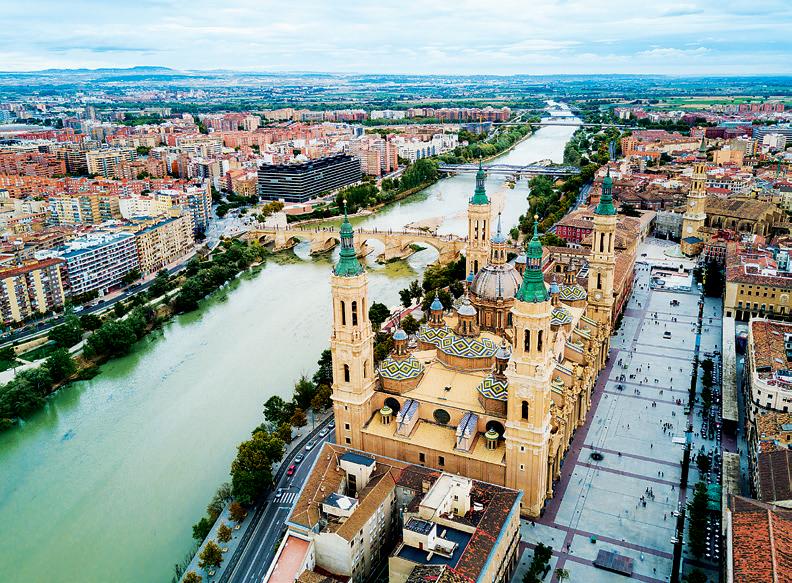
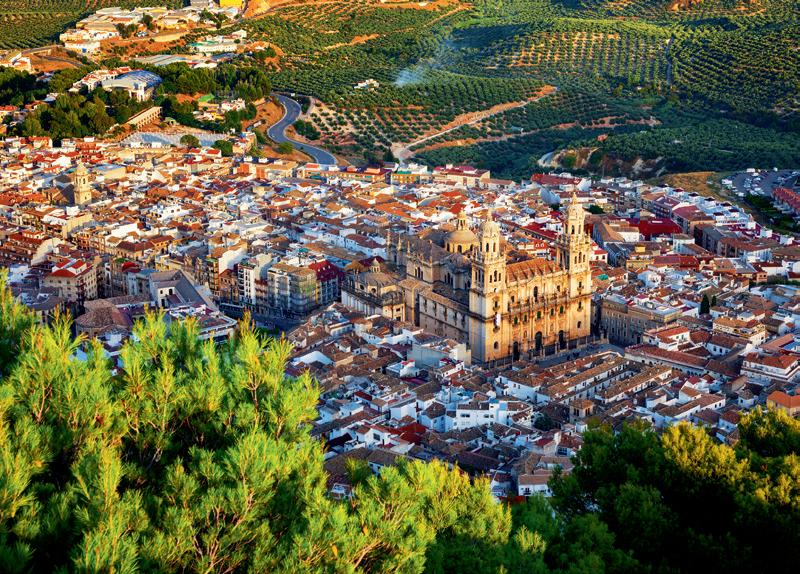
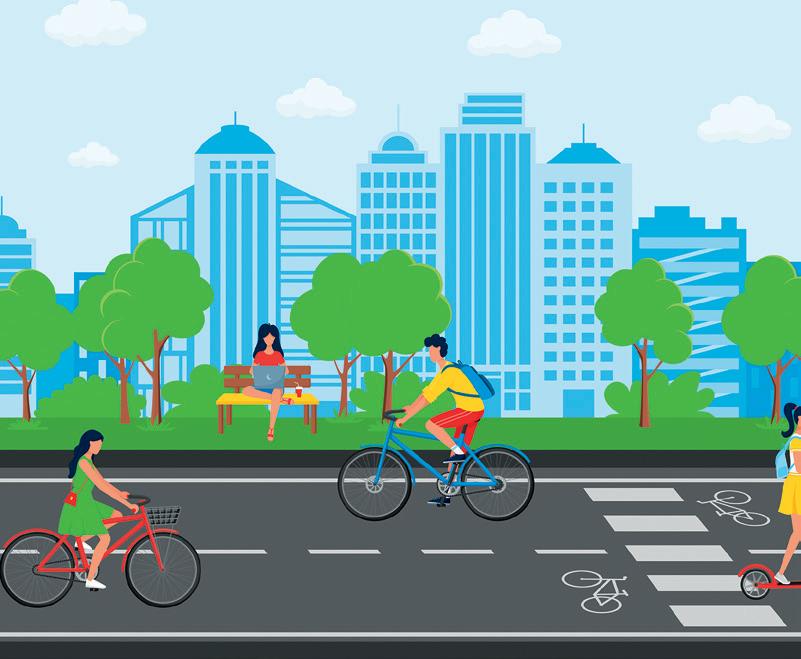
The UN has predicted that 80 % of the global population will be living in cities by 2050. However, many cities are faced with problems such as pollution, mobility, waste management and lack of services. The UN’s New Urban Agenda (NUA) highlights the need for sustainable urban development.
32 The human space 2
View of Cádiz.
Zaragoza, regional metropolis.
Jaén, medium-sized city.
Activities
14 Read the following text and select the basic characteristics and examples of cities of the two models of medieval city: Christian and Islamic.
‘During the medieval period, two peoples with different religions, cultures, and ways of life inhabited the peninsula, which was reflected in two different city models: the Christian and the Islamic.
The Islamic area helped revive already existing cities (Córdoba, Toledo, Granada, Seville) and founded new cities (Almería). Their plan reflected a sinuous layout of narrow and winding streets.
The Christian zone experienced an urban revival from the 10th century, caused above all by the Camino de Santiago (Burgos, Santiago and León). The process of repopulation during the Reconquista enabled the cre ation of new urban centres such as Salamanca, Ávila, Segovia and Soria. Most were small walled enclosures with narrow streets.’
15 Search for a document called 'Urban Innovation and the Im plementation of the New Urban Agenda 2022' on the Urban Agenda Platform website. Choose a city and in your note book, summarise the initiative it sets out.
17 What are the general characteristics of the industrial city? And the post-industrial city?
18 Using the map, order the following cities according to their level of urban hierarchy: Burgos, Antequera, Madrid, Valencia, Málaga, Barcelona, Osuna, Granada, Seville and Castellón.
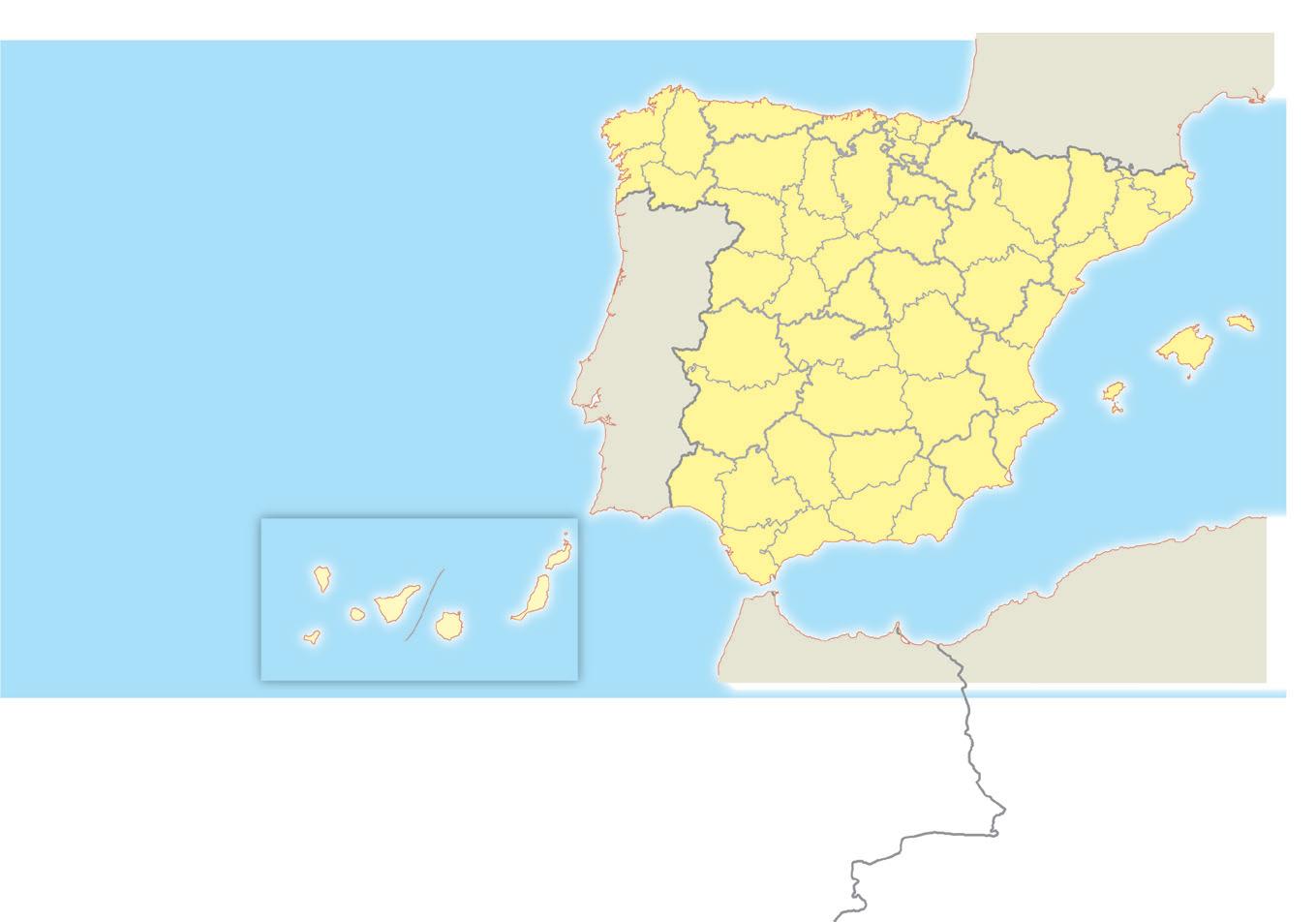
16 Classify the 8 Andalusian provincial capitals according to urban hierarchy.
Task DEFENDING URBAN HERITAGE
Urban heritage comprises cities and towns with special historical and social value and their monuments. Despite laws that protect it, our urban heritage is not always respected. It is also a challenge to reconcile the reality of historic centres with the needs of contemporary society. It is everybody’s responsibility to preserve this legacy for future generations.
Attacks on the heritage of Córdoba
In February 2002, Córdoba was the victim of one of the most shocking assaults against its heritage: the Christ of the Lanterns was painted over with Nazi swastikas, causing national outrage. Eighteen years later, the Marrubial Wall was vandalised with huge multi-coloured graffiti. Over the last few decades, acts of vandalism have occurred in several places in Córdoba.
The reaction to these incidents follows a well-known pattern: local indignation, rapid action by the City Council to remove the graffiti, calls for citizen collaboration and police and judicial investigations to identify the culprits. The costs of restoration are high, and often the damaged objects are irreplaceable. The lack of effective measures to prevent these acts of vandalism are a cause for concern.
Text adapted from ABC Sevilla, 11th October, 2020.
Spanish urban network and its hierarchy


National metropolises
Regional metropolises
Subregional metropolises
Medium cities
Small cities

A. Read the news article and write down your thoughts on it in your notebook. Do you think that the deeds mentioned in the article are just youthful mischief or crimes against national heritage?
B. Search in your local area for an example of criminal damage of urban heritage and take a photo to share in class. How do you think these types of behaviour could be controlled or solved? Debate the question in class.
33 The human space
should be
in your notebook V 2
Writing activities
completed
La Coruña Vigo Oviedo Valladolid Madrid Pamplona Barcelona Zaragoza Murcia Málaga Granada Córdoba Seville Cádiz Alicante Palma Valencia Santander Donostia-San Sebastián Vitoria-Gasteiz Bilbao M edi t e r r a n e a n S e a Cantabrian Sea ATLANTIC OCEAN Las Palmas de Gran Canaria Santa Cruz de Tenerife
Sculpture with graffiti.
Grammar in geography and history
Present perfect Affirmative, negative AND INTERROGATIVE
We use the present perfect (have/has + past participle) to talk about:
Life experiences up to now: ever (in questions); never (in negatives).
z I’ve never been to Málaga.
z Have you ever eaten Greek food?
Actions that finished a short time ago: just.
z They studied Portuguese traditions. They have just opened a travel agency with many Portuguese destinations.
Actions that are completed before or up to now: already (in affirmative); yet (in questions and negatives).
z I have already seen that movie.
z They haven’t opened a social media network yet.
10 questions
1 What distinctions are made in geographic space?
We make a distinction between natural space, human space, rural space and urban space.
2 How is rural settlement classified according to the distribution of the population?
It is classified as dispersed, nucleated or interspersed settlement.
3 How many rural municipalities are there in Spain, and in which autonomous communities are most of them located?
There are 6,671 rural municipalities in Spain, and the autonomous communities with the highest percentages of population registered in rural municipalities are Extremadura, Castilla-La Mancha, Castile and Leon, and Aragón.
4 What activities predominate in cities, and what is urban morphology focused on?
In cities, secondary and tertiary activities predominate. Urban morphology is focused on the external aspect of the city, influenced by its site, plan, construction and land uses.
5 What are the three recognised processes of growth in Spanish cities?
The three recognised processes of growth are the pre-industrial city, the industrial city and the post-industrial city.
1 Choose the correct word in each case:
a) Have you ever/never visited a rural village?
Activities
b) We have just/already attended a workshop on sustainable living.
c) I have never/yet participated in a local farming event.
d) She hasn’t just/already moved to the countryside; it’s been a few years now.
e) He hasn’t decided whether to pursue a career in rural development yet/never
2 Write the following text with the correct tense of each verb in brackets: past simple or present perfect.
The conquest of the Americas and the economic development that it entailed for Lower Andalusia meant that its cities (gain) a new impetus. In the 17th century, the process of urbanisation ( stall ) due to the century-long crisis. In the 18th century the so-called new towns (to be created ), and towns such as La Luisiana (appear) in the reign of Charles III. These populations (to be characterised ) by having a geometric plan, following the Enlightenment objective of model settlements.
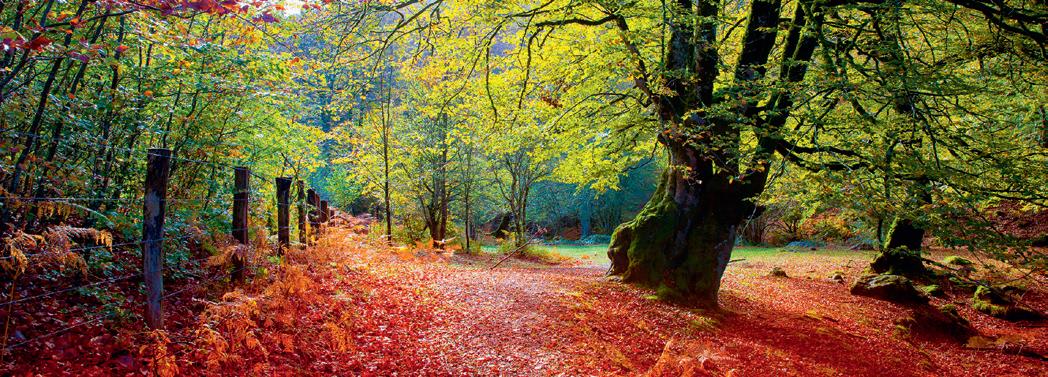
6 How is the urban structure of a city organised and what are its differentiated areas?
The urban structure is organised into different zones with characteristic functions. In a city, there are residential, commercial, industrial, recreational and suburban areas.
7 How many levels of hierarchy make up the urban network?
The urban network has different levels of hierarchy, such as national metropolises, regional metropolises, subregional metropolises, medium cities, and small cities or towns.
8 How many cities make up the Andalusian urban system and which are the most prominent?
The Andalusian urban system is made up of 150 cities, with Seville and Málaga being the most prominent.
9 What are the main challenges facing the rural world?
The main challenges are depopulation, youth unemployment and the lack of services in rural population centres.
10 What transformations are suggested for the urban world in terms of sustainability?
Transformations such as the use of renewable energies, the creation of more green zones, and the search for more sustainable mobility are suggested.
34 The human space 2 Writing activities should be completed in your notebook V
Creating a tourist information leaflet
1
WHAT TO SOLVE?
Tourism is the main economic activity in our country and it creates and sustains many jobs.
Despite its positive aspects, today’s uncontrolled mass tourism causes a number of problems in our urban and natural environment. However, it also creates opportunities in rural areas, where it has become a means to prevent depopulation and the oblivion of many of our towns. It is important to find the right balance to protect our spaces and their value, and that these generate economic profitability. We have to learn to use and diversify tourism resources so that they create wealth and become sustainable, low-impact activities.
2
HOW TO DO IT?
Look at the following website about 3 proposals for rural tourism in Spain (https://www.spain.info/en/discover-spain/small-villages-spain/) and answer the questions below about each proposal you have analysed.
• Why would you visit the locality?
• When is it best to visit it?
• How many days are needed?
• Have you been to this locality before?
Then, in pairs, choose one of them and create a simple information leaflet that contains a catchy slogan and the 3 tourist attractions you consider the most important.

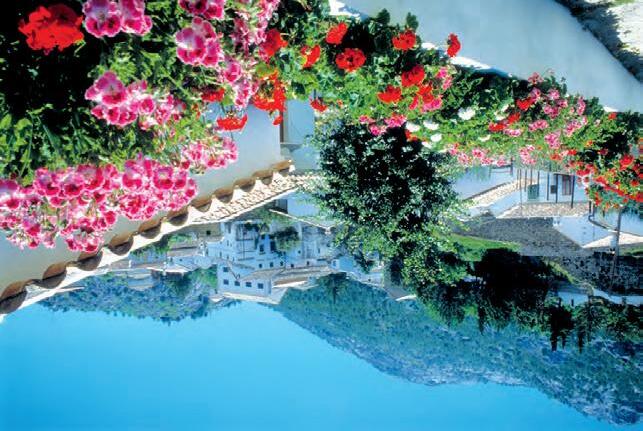
3
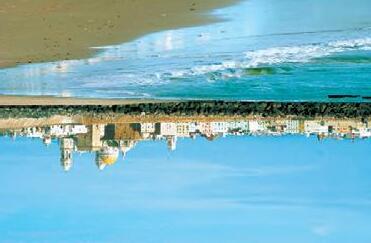
SHARE YOUR EXPERIENCE



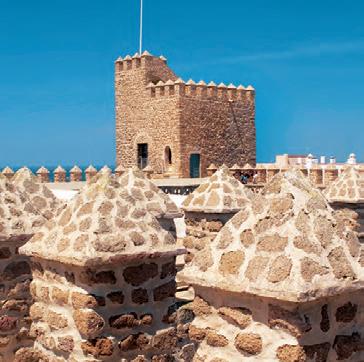
Hang up the leaflets in your classroom so that everyone can learn more about these localities. After reading them, complete the following sentences in your notebook:
• I have been to …
• I haven’t been to…
35 The human space Writing activities should be completed in your notebook V 2
task
final
Cádiz Cádiz Guía Práctica Provincias / Mapa Español Ruta del Toro La Ruta del Toro es una invitación para conocer la vida de este animal en su medio natural y los trabajos de selección para perpetuar la raza del toro bravo. Jerez de la Frontera es el punto de partida de este recorrido que transcurre por la Campiña y concluye en el Campo de Gibraltar. Los pueblos que forman este itinerario son Paterna de Rivera Medina Sidonia Benalup-Casas Viejas Alcalá de los Gazules Los Barrios Castellar Jimena San Roque y Tarifa En esta ruta es imprescindible la visita a algunas de las numerosas ganaderías que existen en la zona. Un complemento perfecto sería la asistencia a algún festejo taurino de los muchos que tienen lugar en la provincia y que se desarrollan en míticas plazas como la de El Puerto de Santa María o en las calles de algunos pueblos. Ruta del Vino Jerez de la Frontera Sanlúcar de Barrameda y El Puerto de Santa María son las tres ciudades que sirven de eje fundamental para esta ruta temática. Este recorrido nos muestra el peculiar paisaje de viñedos, la monumental arquitectura de las instalaciones bodegueras y los genuinos sistemas de crianza de los tipos de vinos más representativos: finos amontillados olorosos y manzanillas. Otras zonas productoras de caldos gaditanos son Trebujena Chipiona Rota Chiclana, y algunos pueblos serranos como Arcos o Prado del Rey Ruta del Caballo Posiblemente Cádiz sea la provincia española donde la tradición ecuestre se manifiesta con mayor fuerza. De hecho, Jerez de la Frontera podría erigirse como capital española del caballo debido a las numerosas ganaderías y yeguadas que se afanan la crianza y selección equina, así como los diversas expresiones festivas que tienen al caballo como protagonista absoluto: la del Caballo declarada Fiesta de Interés Turístico Internacional, y la gran parada ecuestre y el Concurso Internacional de Saltos Hípicos Ancades, con motivo de Fiestas de Otoño Jerez acoge igualmente la Real Escuela Andaluza del Ecuestre y en 2002 fue de los Mundiales gran Sanlúcar sus Dehesa Vejer Los Blancos Artesanía Fiestas y Tradiciones El calendario festivo de la provincia de Cádiz cuenta con citas de gran interés como lo demuestra el hecho de contar con tres Fiestas declaradas de Interés Turístico Internacional: el Carnaval de Cádiz, la Feria del Caballo de Jerez y las Carreras de Caballos de Sanlúcar de Barrameda. Sin duda, éstas y otras fiestas (Semana Santa romerías Corpus Christi...) vienen a reflejar algunos de los elementos característicos de esta tierra, como el vino y el caballo, además de subrayar el carácter hospitalario de su gente. Junto a estas expresiones festivas, la provincia es a lo largo de todo el año escenario de eventos culturales de primer orden como son Alcances Muestra Cinematográfica del Atlántico en Cádiz, y la Muestra de Cine Africano en Tarifa. Otras disciplinas como el teatro la danza o la música también tienen su espacio y destacan citas como la del Festival de Música Clásica A orillas del Guadalquivir” en Sanlúcar de Barrameda. El flamenco adquiere una importancia especial en Cádiz por el hecho de ser cuna de palos autóctonos como las bulerías, tanguillos o peteneras, entre otros; y de grandes figuras del cante y el toque: Camarón de la Isla, José Mercé, Manolo Sanlúca Por supuesto, la provincia brinda la oportunidad flamencos La provincia de Cádiz puede presumir de ser la capital de la marroquinería andaluza Ubrique junto a sus vecinos Prado del Rey y Villamartín, ostentan con orgullo este título. Aquí se puede encontrar cualquier objeto de cuero que cuenta con la calidad garantizada por su etiqueta de “Legítimo Ubrique” Otro tipo de artesanía que hallamos y que escasea en nuestros días es la de los telares. En Grazalema podemos adquirir sus famosas mantas y ponchos elaborados a mano con lanas de primera calidad. Famosos son también los trabajos de tonelería y guarnicionería en Jerez El mimbre la caña y la enea se utilizan artesanalmente en Medina Sidonia Setenil Bornos o Vejer mientras Paterna y Torre Alháquime trabajan la palma y el esparto transformando éste último en cestas y alpargatas Gastor y Algodonales elaboran instrumentos musicales como la gaita gastoreña guitarras La cerámica cuenta en Arcos y Conil con maestros que la moldean, cuecen y esmaltan. Otros trabajos artesanales son las muñecas de Chiclana los botos camperos de Alcalá de los Gazules y Espera, y la fabricación de muebles y sillas de La cocina gaditana está altamente influenciada por los vinos que se producen en la provincia y por la extensa gama de pescados propios de su litoral: doradas, urtas, róbalos, acedías, mojarras, etc., así como por sus mariscos gambas, cigalas, bocas, cañaíllas y los célebres langostinos de Sanlúcar de Barrameda Los productos de la Sierra también aportan una gran riqueza y entre ellos destacan los afamados quesos payoyos y las chacinas como la morcilla, los choricitos de El Bosque... Los platos más típicos de la provincia son la caballa asada con piriñaca urta a la roteña dorada a la sal ajo caliente berza con tagarninas tortillitas de camarones Mención aparte merece el bienmesabe, un adobo especial condimentado con vinagre utilizado para preparar el pescado. La herencia árabe y conventual es posible hallarla en la repostería de la tierra, donde encontramos dulces como las tortas chiclaneras almendradas, los alfajores de Medina Sidonia y el turrón de Cádiz, entre otros. El vino, que cuenta con la Denominación de Origen JerezXeres-Sherry y Manzanilla de Sanlúcar, tiene como variedades el fino amontillado oloroso moscatel y manzanilla Gastronomía Rutas Cádiz Fundada por tartesos y fenicios hace más de 3.000 años, esta tierra ha sido hogar de numerosos pueblos como visigodos, romanos y musulmanes, entre otros. Unos 1.100 años a.C se fundó la mítica Gadir convirtiendo a la capital de la provincia en la ciudad más antigua de Occidente. Los romanos dejaron sus huellas en ciudades como Baelo Claudia en Tarifa y Carteia en San Roque Sin embargo, pinturas rupestres como las del “Tajo de las Figuras” en Benalup o los sarcófagos fenicios mostrados en el Museo de Cádiz, confirman la presencia de culturas anteriores. A partir del año 711 fue territorio musulmán hasta la segunda mitad del s. XIII, cuando Alfonso X El Sabio la reconquistó y anexionó al Reino de Castilla. En estos siglos el paisaje provincial se pobló de castillos torres y fortalezas que aún hoy en día son posible admirar sobre espolones rocosos como es el caso de Zahara de la Sierra Olvera y diseminados por la costa como en Tarifa Chiclana... La arquitectura religiosa cuenta con obras de gran valor como son La Cartuja de Jerez y las catedrales de Cádiz y Jerez El papel activo que jugó la provincia en el descubrimiento y colonización de América se Arte y Cultura O cinas de Turismo de Cádiz de la Junta de Andalucía Avda. 4 de diciembre de 1977, s/n. 11005 Cádiz Tel.: 956 203 191. Correo e.: otcadiz@andalucia.org Algeciras Paseo Río de la Miel, s/n. 11207 Algeciras Tel.: 670 949 047. Correo e.: otalgeciras@andalucia.org La Línea de la Concepción Avda. del Ejército, Esquina 20 de abril 11300 La Línea de la Concepción Tel.: 956 784 135. Correo e.: otlinea@andalucia.org JUNTA DE ANDALUCÍA Consejería de Turismo Deporte Empresa Pública para la Gestión del Turismo y del Deporte de Andalucía, S. A. C/ Compañía, 40. 29008 Málaga www.andalucia.org 1338-2018
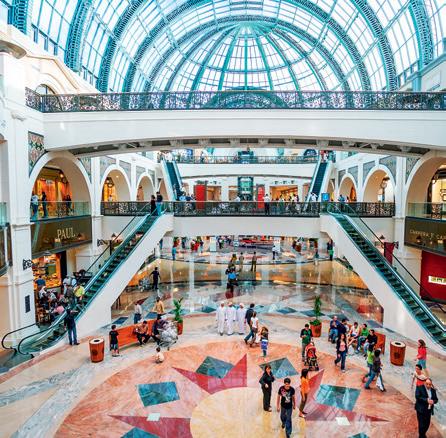
3 The economic systems
➊ HOW DO WE SATISFY OUR NEEDS? ECONOMIC ACTIVITIES
Economic activities consist of the production of goods and services to satisfy human needs and desires.
Producers are those who provide goods and services in exchange for economic profits (supply) and consumers pay for these goods and services (demand)
The marketplace is the place where these exchanges happen. Economic activities can be divided into extraction and production, distribution and consumption. We classify them into three sectors:
z The primary sector consists of the extraction of raw materials from the natural environment: agriculture, livestock farming, fishing, hunting, mining and forestry.
z The secondary sector groups activities that transform raw materials into products: construction and industry.
z The tertiary sector includes activities related to services, such as healthcare, education, commerce, finance and tourism, etc.
1.1. The factors of production
The factors of production are those elements necessary to produce goods and to provide services. These are:
z Natural resources are products obtained directly from nature, such as raw materials and energy.
z Work is the human activity, physical or mental, necessary to produce goods and services.
z Capital refers to the material resources that do not come from nature and which are necessary for production. We distinguish between physical capital (buildings, machinery, etc.) and financial capital (the money needed to run a business).
z Technology and knowledge include the research, development and application of innovative techniques to improve production and distribution processes.
1.2. Economic agents
Economic agents are responsible for making economic decisions. There are three economic agents: households, companies, and the state.
HOUSEHOLDS
COMPANIES
• Companies produce goods and services, and pay salaries and taxes. They gain economic profits and receive public services, subsidies and grants.
• Households are involved in the economy as workers, as consumers of goods and services, and they pay taxes to support public services.
Gross Domestic Product
GDP (Gross Domestic Product) is the value of all goods and services produced in a country during a specific period of time. The weight of each economic sector in GDP varies in each country or region depending on the level of economic development: in developing countries, the primary sector plays a predominant role, whereas in developed regions the tertiary sector is the main one.
Spain Somalia
Primary Secondary Tertiary
Source: INE and Ministry of Foreign Affairs (2022).

Investment in R&D&I is essential to encourage innovation, promote economic growth, solve global challenges and improve quality of life. It is a vital driver of progress in many sectors and is fundamental for sustainable development and competitiveness in the global economy.
PUBLIC ADMINISTRATION
• The public sector is, at the same time, a consumer and a producer of goods and services. Through taxes, it provides public services (healthcare, education), builds infrastructure (roads, street lighting), and offers subsidies and grants.
26 The economic systems
1 Work in pairs or groups and discuss the following questions. Write your answers in your notebook.
a) Do you think the study of the economy is important nowadays? Explain your answer.
b) Think about the last product you bought and try to describe the process that it has gone through in production, from its origin to your hands.
c) Discuss with your partners and then put these jobs in the correct column: farmer, nurse, police officer, fisher, furniture maker, computer programmer, builder, miner, teacher, factory worker, baker.
4 What is the difference between goods and services? What do they have in common? Write some examples of goods and services.
5 Classify the following factors of production and complete the table in your notebook:
a) Money.
b) Putting documents in order for eight hours.
c) Knowing the ingredients for a recipe.
d) An industrial warehouse.
e) Iron.
f) Loading sacks of cement.
g) A spanner.
h) A welder robot.
i) Selecting workers for a company.
d) Do you get weekly pocket money? If so, how do you manage it? What do you spend it on?
2 Look at the following pictures. Which of the three economic sectors do they correspond to? Write a short paragraph to explain the different stages of the production of goods and services and connect them with the economic sectors, using the pictures as an example.
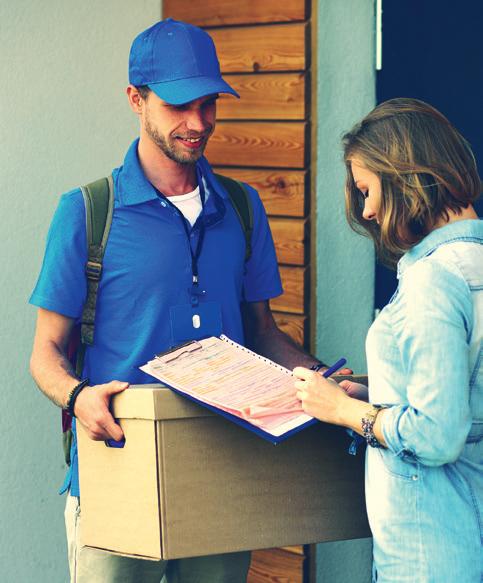
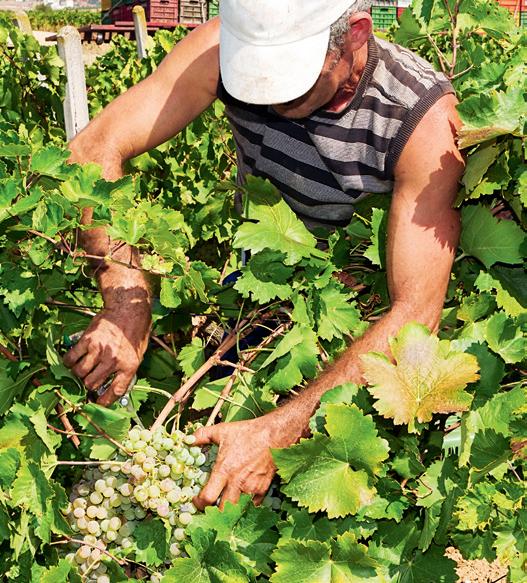
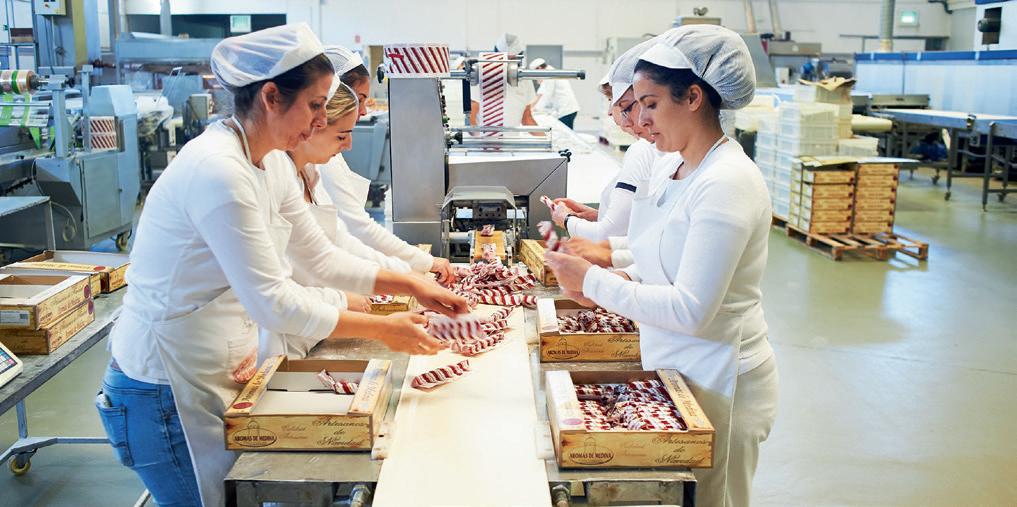
3 Are these statements true or false? Correct in your notebook the false ones.
a) Families consume thanks to the money they receive from taxes and pay wages.
b) Companies produce but they don’t consume anything.
c) The secondary sector includes activities that transform raw materials into products.
d) Physical capital is products obtained directly from nature, such as raw materials and energy.
e) Demand includes all the goods and services produced by companies, which are available in the marketplace and consumers can pay for.
j) 30 years’ experience as a bricklayer.
k) Oil.
l) Wood.
m) Knowing how to classify textile products.
6 2 Listen to the audio recording about the role of economic agents in the economy and fill in the gaps in your notebook with the correct words:
In a city there is a that makes biscuits. This company employs several local for making biscuits. These workers, in turn, belong to who live in the same city. The workers’ families, such as the García family, buy the biscuits produced by this company to cover their nutritional . To acquire these biscuits, they allocate part of their monthly income, which comes from the obtained by the family members who work in the biscuit factory and in other places. The local government of this city also plays an important role. It collects from the biscuit company and from the families to pay for in the city, such as the education of the workers’ children, the improvement of local infrastructure, and security.
7 In your notebook, copy and complete the following table about the role of economic agents:
8 What are taxes? Why do you think they are important for the economy?
27 The economic systems
activities should be completed in your notebook V 3
Writing
Primary sector Secondary sector Tertiary sector Natural resources Capital Work Technology and knowledge Households Companies State They provide They obtain a) b) c)
Activities
➋ ECONOMIC SYSTEMS
An economic system is the way in which resources, production and distribution of goods and services are organised and managed in a society. These systems determine the structure and functioning of a country’s economy. Throughout history, different economic systems have been developed:
Primitive
communal system
Slavery system
Feudal system
Mercantilist system
During prehistory, society was organised in clans and the economy was based on hunting and gathering. There was little specialisation and the economy was based on satisfying basic needs.
During Classical Antiquity, the economy was based on the exploitation of certain people (slaves) by other people (masters). Production was focused on trade and accumulation of wealth.
This existed during the Middle Ages with the feudal monarchies. The lords gave their lands to the serfs in exchange for agricultural production. In return, the serfs received protection.
This system was typical of the authoritarian monarchies of the Early Modern Period. It is based on the accumulation of wealth through international trade.
Today, we can distinguish three economic systems:
Free market
Planned economy
Mixed economy
➌
This is based on economic freedom. Most companies are private property that seek to gain maxim profit. The market is regulated through the law of supply and demand. The state does not play a large role.
Most companies are state-owned. The state controls the production of goods and services through their economic plans, so there is no economic freedom.
This is the most widespread economic system in the present day. Most companies are private, but there are also state-owned companies. There is economic freedom, although the state plays an active role. Its goal is to achieve a more equitable distribution of wealth, through a progressive fiscal system and a supply of public services of social interest.
COLONIALISM, IMPERIALISM AND OTHER FORMS OF SUBORDINATION
Throughout history, different formulae have been used to control other territories from the economic, political and cultural point of view.
z During the Early Modern Period, colonialism was developed. Some countries of Europe exploited the natural resources and labour of other territories of Africa, North and South America, Asia and Oceania. They also imposed their culture, their language, and their values.
z In the 19 th century, imperialism appeared. The main European powers and the USA dominated almost the whole planet politically and territorially. After the end of the Second World War and the founding of the UN (1945), the process of decolonisation began.
z From the 20th century onwards, other mechanisms of economic and cultural subordination came into play: with neocolonialism, the former colonial powers maintain influence and economic control over their former colonies, even after their independence; due to globalisation, the economy has intensified the process of subordination of local economies to the economy of the global market.
The law of supply and demand
Supply Demand
Supply is greater than demand: prices go down
Demand is greater
than supply: prices go up
Prices go down: demand increases
The law of supply and demand determines the value of goods and services in the marketplace based on the needs that consumers have (demand) and the quantity of the different goods or services available in the marketplace (supply).
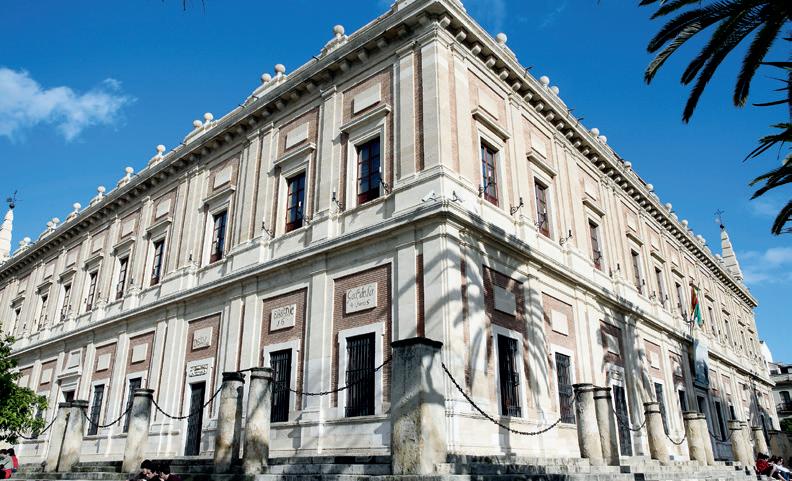

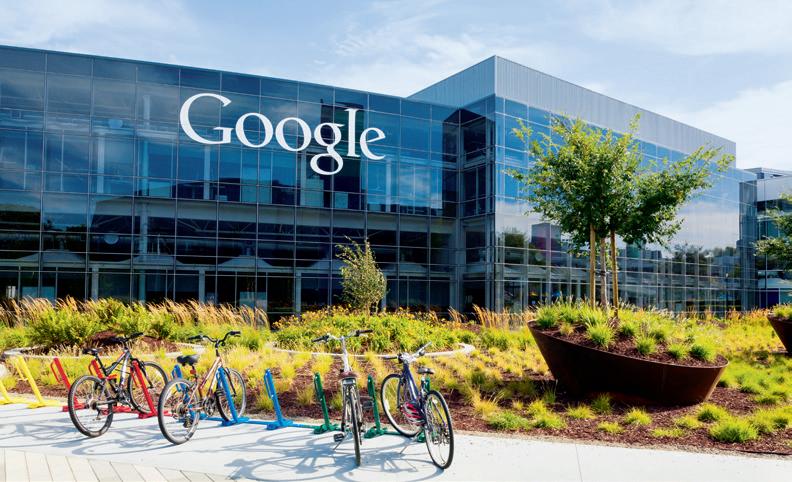
28 The economic systems 3
Textile factory in Barcelona in the 19th century.
Google headquarters in California (United States).
The General Archive of the Indies (Seville) was the headquarters of Spain’s trade with the Americas.
9 What economic system do these statements correspond to? In your notebook, copy each sentence in the correct column.
a) State intervention in the economy is compatible with economic freedom.
b) Prices rise and fall according to the law of supply and demand.
c) The state owns most companies.
d) It is the most widespread economic system today.
e) This economic system seeks to reduce inequality between the richest and the poorest.
f) The state establishes the quantities that can be produced, as well as the prices of the products.
g) Its goal is individual profit, based on private property.
10 In your notebook, copy and complete the chart about the economic systems that exist in the present day. Then, think about advantages and disadvantages of each one and discuss with your partner which would be your ideal economic system.
Ownership of the means of production Role of the state Objective of the system Functioning of market: prices and wages
13 2 Listen to the audio recording about the evolution of capitalism and match the three columns in your notebook.
I. It is characterised by large economic inequalities.
1. Early capitalism
2. Industrial capitalism
3. Finance capitalism
4. Contemporary capitalism
a) Current Day
b) 18th and 19th centuries
c) 19th and 20th centuries
d) Middle Ages and Early Modern Period
II. More complex financial institutions, such as the stock market, were created.
III. It is characterised by the accumulation of capital through trade routes.
IV. The steam engine was invented in this stage.
V. Multinationals play an extremely important role in this stage.
VI. The working class emerged.
14 Read and answer the questions in your notebook.
11 Do you know the difference between a state-owned company and a private company? Write two examples of private and state-owned companies that you know.
12 Write the following sentences about the law of supply and demand, choosing the correct word from the pairs suggested:
a) If the price of rice is very low, rice consumption will fall/ rise, which could cause the produce to become scarce and, in the long run, increase/decrease the supply. In this case, consumers will be prepared to pay much more/less for the rice.
b) If many years of drought occur and the olive harvest is poor, but the population continues to consume olive oil in the same way, the price of olive oil will fall/rise
c) If a new factory opens but there are not enough qualified workers, the wages the company offers will fall/rise.
d) If the latest model of a well-known and in-demand mobile phone appears on the market, its price will decrease/increase. However, the demand for the older models of this brand will fall, leading to the accumulation of stock, and therefore the shops will lower/raise their prices.
VUp until the Early Modern Period, processes of colonialism took place, with both economic and cultural aims, and also imperialism, which included goals of political control. This phenomenon has its origin in the establishment of colonies by European powers in Africa, North and South America, Asia and Oceania. Imperialism and colonialism intensified at the end of the nineteenth century, beginning a process of economic, political and cultural domination at this time by the main European powers and the United States. In the year 1914, 84 % of the world’s land was under their control. In Africa, there were only two independent states: Abyssinia (Ethiopia) and Liberia. When the United Nations was founded in 1945, almost a third of the world population lived in territories that depended on colonial powers. Since then, a process of decolonisation began, and most of the former colonies gained their political – but not economic – dependence. A good example of this is Africa, a continent that is very rich in precious metals like gold. In many cases, the control of their mines was held by companies from developed countries, prolonging the situation of subordination that has lasted from the colonial period until today.
a) According to the text, what is the main difference between colonialism and imperialism?
b) Which two African countries were the only ones not to be under the control of imperial powers before 1914?
c) What is the UN? Explain when it was founded and how it had an influence on imperialism and colonialism.
d) What name do we give to the economic subordination that the former colonies still suffer today and that is described in the text, in the case of Africa?
29 The economic systems
notebook
Writing activities should be completed in your
3
Activities
Market
Planned system Mixed system
system
➍ HOW MARKETS WORK IN A GLOBAL ECONOMY
The adoption of the capitalist system by most countries in the world has enabled the development of the global economy. This process is possible thanks to the progress in telecommunications and the improvement of infrastructure and the means of transport. Information, money and merchandise are moved on a global scale rapidly and efficiently.
The most important characteristics of globalisation are:
z Increase in international trade, due to the reduction of trade barriers and the development of trade agreements.
z The internationalisation of the financial markets.
z The strengthening of the multinationals.
z Industrial offshoring.
z The control of economic activity by international bodies.
4.1. Multinationals and offshoring
Multinationals are companies that operate in many different countries. The subsidiaries or dependent companies of these multinationals relocate to developing countries in order to reduce production costs and increase profits. This phenomenon is called offshoring.
4.2. World economic regions
We can distinguish between different regions according to their degree of integration in the global economy:
z Highly developed regions. These include North America (particularly the United States), western Europe and Japan. These countries have a high level of technological development, and lead global trade. Their populations enjoy a high level of life that enables a large consumption of goods and services.
z Emerging countries are characterised by rapid economic growth. The five main emerging countries are Brazil, Russia, India, China and South Africa (BRICS). These countries have profited from industrial offshoring and have specialised in the exportation of industrial, agricultural, mineral and energy products. They suffer from unresolved problems: exploitation of their workers, and the heavy environmental impact of their industrial activities.
z Undeveloped countries are located in Sub-Saharan Africa, Asia and Latin America. They have traditional agricultural production, poorly developed industry, little participation in international trade, and a general low level of life in their population.
➎ DILEMMAS AND UNCERTAINTIES OF TODAY’S ECONOMY
z Climate change and environmental degradation, and the transition to a sustainable economy.
z Economic and social inequalities caused by globalisation.
z Rapid technological progress (automatisation, artificial intelligence) represents a threat to many traditional jobs.
z Political and economic tensions in any part of the world can affect the international economy.
z Excessive dependence of the advanced economies on developing countries. Many developed countries propose a change toward relocation.
Main International Economic Bodies
International Monetary Fund (IMF)
World Bank (WB)
World Trade Organization (WTO)
Organisation for Economic Cooperation and Development (OECD)
Promotes the financial stability and development of a sustainable and fair economy.
Offers financial assistance to developing countries to reduce poverty and improve education and infrastructure.
Facilitates the creation of trade agreements and settles disputes between its members, to enhance the development of international trade.
Promotes policies to improve the economic and social wellbeing of all people around the world.


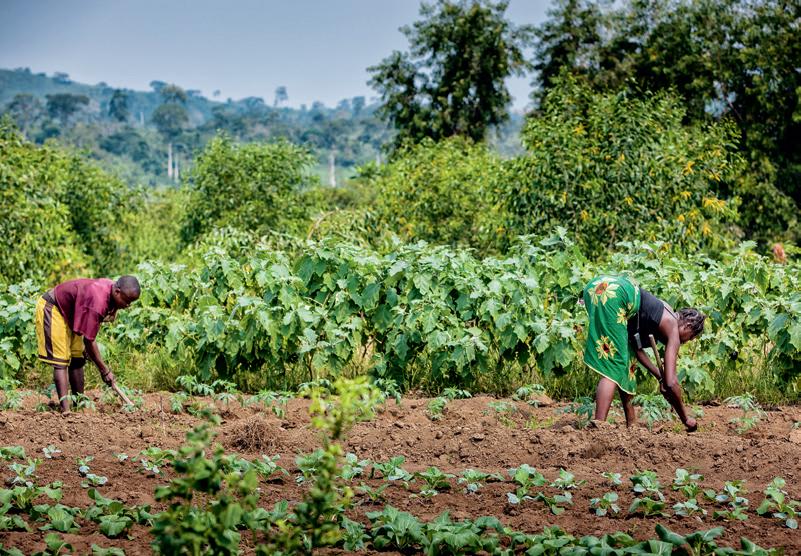
30 The economic systems 3
Textile industry in India.
Farming in the Democratic Republic of the Congo.
City of London (financial centre).
Activities
15 2 Listen to the audio recording. Are these statements true or false? Correct the false ones.
a) The relocation of factories to developing countries has caused an increase in prices.
b) Offshoring has caused an increase in unemployment in less developed countries.
c) Industrial offshoring causes an increase in pollution in developing countries.
d) Offshoring has brought about an increase in consumption worldwide.
16 Look at the world industrial location map and answer the following questions:
17 Read this text about fair trade and answer the following questions:



Developed regions
Centres of power of developed regions
First-tier emerging regions
Second-tier emerging regions
Supra-regions of emerging economic growth
Industrial relocation
Second phase of relocation
a) Where are the centres of power of developed regions located?
b) Write down the names of five emerging countries. In which continent are they mainly located?
c) Search online to find the most important industrial sectors in emerging countries.
d) Compare this map with the map of the colonial empires that you have in your book in Spanish. Could there be any connection between the current situation and imperialism?
In the current capitalist economy, consumers look for products at the cheapest price, without taking into account the conditions in which they were produced. In recent decades, an alternative idea has appeared called fair trade, which tries to promote fairer relationships between producers, intermediaries and consumers while respecting the environment and biodiversity. Fair trade is based on ideas like the preservation of natural resources, the protection of local markets, the struggle against the use of child labour, and the promotion of gender equality. Therefore, if we want to save the environment, respect people and pay a fair price for things, we should consider this system of commercial solidarity.
a) What is fair trade?
b) Why does fair trade demonstrate more solidarity than traditional trade?
c) Have you ever bought a fair-trade product?
18 Copy this table in your notebook and complete it with the following characteristics of the different economic regions:
Most developed regions Emerging countries Least developed regions
a) They have become specialised in the export of industrial, mineral and energy products.
b) Their economy is based on traditional agricultural activities.
c) Their economies have benefited from industrial offshoring.
d) Their population is characterised by a high consumption of goods and services.
e) They are mostly located in Sub-Saharan Africa, Asia and Latin America.
f) The countries known as BRICS head up this group.
g) These countries dominate the political, commercial and economic decisions of the global economy.
19 Explain what a multinational company is and find five examples of it, indicating its country of origin, the products it makes and where its factories are located.
Task THE 7Rs OF THE CIRCULAR ECONOMY
The circular economy is an economic model that seeks a more efficient use of resources and to reduce the generation of waste. It is a model of production and consumption, which involves sharing, leasing, reusing, repairing, refurbishing and recycling existing materials and products as long as possible. In this way, the life cycle of products is extended. To do this, it is based on the so-called ‘7Rs’, seven key principles and actions to apply in production and consumption processes’.
A.
Research on the internet what the ‘7Rs’ are, briefly describe each of them and write a specific example of how you can put them into practice Recycle
31 The economic systems Writing activities should be completed in your notebook V 3
Rethink Reduc e Refuse Reuse
Rot NORTH AMERICA CANADA JAPAN
ARGENTINA
TÜRKIYE PAKISTAN
INDIA CHINA SOUTH-EAST
AND NEW ZEALAND
RepuRpose
MEXICO
BRAZIL SOUTH AFRICA NIGERIA EGYPT
BANGLADESH
ASIA AUSTRALIA
Grammar in geography and history
Past simple
The past simple is used to talk about something that happened in the past, and the action is finished
z Regular verbs: verb + d or ed.
z We use did to make questions. Questions with who often don’t use did
z Did Henry Ford invent the production line?
z Who invented the term ‘neurodiversity’?
z We use did not or didn’t to make negatives.
z They did not use nuclear energy for cars.
1 Complete with the correct form of the past simple tense (positive or negative) of the verbs in brackets:
a) The COVID-19 pandemic (to cause) an unexpected effect on the world economy, since the economies of different countries (to be) prepared for a health crisis of that mag-
10 questions
1 What are economic activities?
They consist of the production of goods and services. We classify them into: the primary sector (agriculture, livestock farming, fishing, hunting, mining and forestry); the secondary sector (industry and construction); and the tertiary sector (services, such as healthcare).
2 What are economic agents and what role do they play?
These are households, involved as workers and consumers; companies, that produce goods and provide services; and the state that charges taxes, provides public services and grants, and regulates the economy.
3 What production factors are necessary to produce goods and services?
The main are natural resources, work (human activity, physical or mental, capital (money, buildings, machinery, etc.), and technology and knowledge (techniques employed in the production of goods and services).
4 What is an economic system? What types of economic systems have existed throughout history?
It is the way in which resources, and the production and distribution of goods and services, are organised. There have been different systems: primitive communal, slavery, feudal, mercantilist, socialist and capitalist.
5 What economic systems exist today?
The planned economy, in which the state controls the production and distribution of goods and services; the free-market system, based on the law of supply and demand; and the mixed economy, based on the free market but with significant state intervention.
Activities
nitude. The economic recovery (to be) slow and uneven: the most developed countries (to manage) to apply efficient economic measures, but emerging economies (to have) the necessary tools to do so, which (to increase) inequalities between them.
b) Russia (to invade) Ukraine in February 2022, causing a serious humanitarian crisis in the region but also an impact on the global economy. Just one month after the invasion, the price of electricity, gas and petrol (to increase). Europe (to be) prepared for this aggression and (to anticipate) the consequences of the Russian attack on the supply of fundamental products, especially energy.
2 Order these words to make meaningful questions:
a) last much they How raise did your year salary?
b) British independent When Nigeria Empire did become from the?
c) during industrial cause changes did factories of machines in the introduction revolution What?
d) increase products such war cornflower cause cereals did in Ukraine oil the price of Why agricultural as or the?
6 What is capitalism? How has it evolved?
It emerged in Europe at the end of the Middle Ages. Throughout history, it has gone through different phases, reaching economic globalisation in the present day.
7 What forms subordination have existed throughout history?
In the 19th century, there was colonialism and imperialism. European powers and the US controlled colonial territories. When the colonies became independent, this subordination transformed into neocolonialism and evolved into globalisation.
8 What are the characteristics of the economy today?
The increase in international trade thanks to improvements in infrastructure, the international financial markets, the power of multinationals, industrial relocation, and control by international organisations.
9 How can we classify the regions of the planet according to their level of economic development?
We distinguish between highly developed countries (USA, Western Europe and Japan), emerging countries (BRICS, Southeast Asia, America, Oceania, the Middle East and North Africa) and least developed countries (Sub-Saharan Africa, Asia and Latin America).
10 What challenges does the current economy have?
Climate change and the transition toward a sustainable economy, economic and social inequalities, rapid technological progress and its threat to jobs, political and economic tensions and their effect on the international economy, and the excessive dependence of the advanced economies on developing economies.
32 The economic systems 3 Writing activities should be completed in your notebook V
Globalisation, a model under debate
1
WHAT TO SOLVE?
Economic globalisation is the prevailing economic model of the present day, and it has some aspects that are beneficial and others that are considered harmful. It is important to think about this.
After reading the following texts and looking at the photographs regarding the consequences of globalisation, state which text and which photograph reflect a positive aspect and which reflect a negative one. What effect do you think they are referring to?
In 2020, Amazon generated a total of 270,000 tonnes of waste from plastic pack- aging, and of that amount, 10,700 tonnes ended up in marine and fresh-water environments, according to a report by Oceana, which highlights the ‘huge con- tribution’ of the company to the pollution of the oceans.
Adapted text https://www.elconfidencial.com
The pandemic has worsened the labour situation of women in Bangladesh who work in clothing factories, according to a report carried out by the University of Aberdeen in Scotland, in the United Kingdom […]. Many fashion houses and brands outsource the production of clothing to developing countries such as Bangladesh, India or Morocco, where workers’ rights are almost non-existent and the minimum wage is far lower than in the western countries where they sell their products.
Adapted text https://www.lavanguardia.com
2
HOW TO DO IT?
Working in groups, classify the following effects that economic globalisation has, bearing in mind their typology (economic, social, and cultural) and their benefits and drawbacks. You can brainstorm ideas and add more effects:
• Cultural exchanges are encouraged.
• Huge development of technology.
• Causes the growth of the economy.
• Consumption of goods and services increases too much.
• Western culture is imposed throughout the world.
• Causes labour exploitation.
• Negative impact on the environment.
• Movements and access to information are faster and easier.
3
SHARE YOUR EXPERIENCE

• It is cheaper to produce goods and services.
• Economic inequality increases.
Once you have analysed some effects of globalisation, write a short essay in order to show this analysis and give your personal opinion on the debate. To do this, you should use the following structure:
Introduction: Briefly state what the topic is, in this case, globalisation.
Body: you should present the arguments for and against, which you have described in the previous exercise. You should use some of these expressions: on the one hand; on the other hand; it is a fact that; in contrast; firstly,… Secondly, … Finally; in addition; moreover; however,…
Conclusion: Briefly summarise the arguments and expound your personal position. Some of these expressions can help you: To sum up; In conclusion; Therefore.
Lastly, create a short video (approximately one minute long) in which you summarise the conclusions of your group. Pay attention to pronunciation.
33 The economic systems
V 3
Writing activities should be completed in your notebook
final task
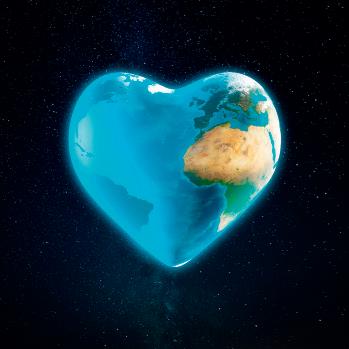
7 Environmental challenges and eco-social awareness
➊ THE IMPACT OF HUMANS ON THE ENVIRONMENT
In the course of the relationship between humanity and the physical realm, humans have gone from a null level of intervention to an extremely significant impact:
z Palaeolithic: The population of the planet was not very numerous. Hunting and gathering took resources from the environment that were replaced by natural cycles. Low human impact.
z Neolithic: Populations settled, grew and began a more systematic exploitation of their surroundings through agriculture and raising livestock. Medium human impact.
z Industrial Revolution (18th century): Technological development increased the population and the exploitation of the planet’s resources. Over-exploitation and pollution created problems in the natural environment and altered the terrestrial surface. Medium-high human impact.
z Present day: The impact of human beings on the physical environment has become the main problem we face as a species. Alarm bells are ringing on the social, political and economic level.
➋ PLANETARY BOUNDARIES
In the year 2009, at the Stockholm Resilience Centre, the concept of planetary boundaries∞ was created. Boundaries are interrelated processes: this means that a global focus on climate change ∞ alone is not sufficient for increased sustainability. Instead, understanding the interplay of boundaries is key in science and practice.
This concept refers to nine biophysical processes. If one of those processes is exceeded, it would endanger the stability of the Earth system ∞ .

F
Safeoperatingspace
C
A1 CO2 concentration
A2 Radiactive forcing
F1 Genetic
F2 Functional
G1 Freshwater use (Blue water)
G2 Green water
I1 Phosphorus cycle
I2 Nitrogen cycle
Source: Stockholm Resilience Centre.
Researchers from around the world have recently quantified the maximum thresholds of those boundaries. According to them, six of the boundaries have already exceeded the values considered normal. The good news is that one of them, the ozone layer, is no longer a planetary boundary under threat.
VOCABULARY
Climate change: the radical alteration of the Earth’s climate caused by human actions.
Earth system: the term refers to Earth’s interacting physical, chemical and biological processes. The system consists of the land, oceans, atmosphere and poles. It includes the planet’s natural cycles —the carbon, water, nitrogen, phosphorus, sulphur and other cycles— and deep Earth processes.
Planetary boundaries: they are a framework to describe limits to the impacts of human activities on the Earth system. Beyond these limits, the environment may not be able to self-regulate anymore.
Earth Summit
‘Earth Summit’ is the term given to the UN Conferences on the Environment and Development (UNCED), and is an exceptional kind of international meeting between the heads of state of all the countries of the world who seek to reach agreements on the environment, development, climate change, biodiversity, and other related issues. Since 1992, there have been four sessions of the Earth Summit: Rio 1992, Johannesburg 2002, Rio 2012 and Paris 2015.
60 Environmental challenges and eco-social awareness
Increasing risk I2 G2 F2 A2 I1 G1 F1 A1
Biogeochemical flows
Climate change
Freshwater
I
A
G
change H Novel entities
E Stratospheric ozone depletion
D Atmospheric aerosol loading
Ocean acidification
B Land-system change
Biosphere integrity Nitrous oxide Gas Atmosphere Dioxide Emission Kyoto Protocol Ecology Treaty Global warming Warming Greenhouse gas Climate change Agreement Industry Methane
Activities
1 Define these terms in your notebook.
a) Deforestation.
b) Acidification.
c) Microplastics.
d) Atmospheric aerosols.
2 Match the causes with their consequences. Then construct sentences using ‘due to’ and ‘caused by’.
4 2 Listen to the audio recording and complete the text. Then answer the questions below.
e)
f)
g)
g)
3 Describe the following pictures and say which type of pollution is associated with each of them.
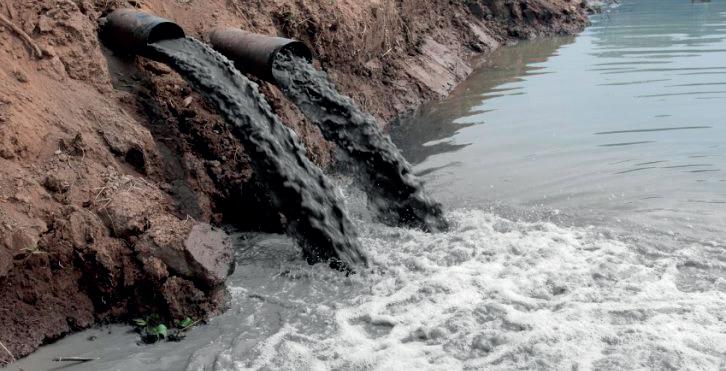

More and more plastic is in our oceans and seas. It comes from rubbish that we on the street, but also from synthetic clothing and our teeth. All these different types of plastic together form a plastic soup in the seas and oceans. Sunlight and wave action large pieces of plastic into small pieces. This causes serious pollution. In 1997, Captain Charles Moore from Hawaii to southern California, taking an unusual route that him through the North Pacific Gyre. There, in the middle of the Pacific Ocean, he pieces of plastic floating by every day. He later to this area. There to be a significantly higher concentration of plastic there than elsewhere in the ocean. The plastic not only to float, but also to be carried by the water column. Moore this phenomenon the ‘plastic soup’, a term which is now used around the world. The oceans 72 % of the Earth’s surface and are our primary oxygen suppliers. They are the primary source of food for more than half the world’s population. But because plastic is not biodegradable, the plastic soup is lethal for many marine animals.
a) Classify the verbs that appear in the text into these tenses: Present simple, Past simple and Past participle.
b) Write a definition for ‘plastic soup’. Who coined this term?
5 Match each type of pollution with its description.
a) Air pollution
b) Water pollution
c) Soil pollution
d) Radioactive contamination
e) Noise pollution
6 2
1. The result of waste from economic activity and the mismanagement of urban waste, which ends up in rivers, lakes, aquifers and seas
2. Produced by an artificial increase in the amount of radiation in the atmosphere
3. The result of the emission of polluting gases as a consequence of the use of fossil fuels
4. An increase in noise levels above what is considered healthy
5. A consequence of the accumulation of rubbish and solid waste
Listen to the audio recording and answer the questions:
a) Why does the article state that the Earth is a sick planet?
b) How many scientists made up the commission that carried out the study?
c) How many planetary limits were examined by the study?
d) Of the planetary limits in the study, which is the only one that has not been exceeded?
61 Environmental challenges and eco-social awareness Writing activities should be completed in your notebook V 7
Cause Consequence
Mass cutting down of trees 1. Climate change
Microplastics 2. Loss of biodiversity
Excessive use of fertilisers 3. Toxic substances in the environment
Fires, illegal hunting, and over-fishing 4. Atmospheric aerosols
a)
b)
c)
d)
Industrial pollution and vehicle emissions 5. Acidification of the oceans
Uncontrolled use of water 6. Lack of availability of water
Global warming
High proportions of nitrogen and phosphorous in agriculture
7.
Burning of fossil fuels and cutting down forests 8. Deforestation
a) b)
➌ THE CLIMATE EMERGENCY
Human beings have caused a change in the climate patterns of our planet. This is a consequence of our activities based on burning fossil fuels (oil and coal), deforestation, uncontrolled livestock farming, the use of fertilisers in agriculture with nitrogen, or fluorinated gases emitted into the atmosphere.
The concentration of greenhouse gases in the atmosphere is clearly linked to the increase in temperatures. Two of the gases responsible for global warming are carbon dioxide (CO2) and methane (CH4). These gases retain the heat that the sun has radiated onto the Earth’s surface and they prevent it from escaping to outer space. This causes a warming of the planet surface, which is called the greenhouse effect.
This climate change has huge consequences:
z The destruction of ecosystems.
z The loss of land.
z Higher recurrence of extreme meteorological phenomena such as droughts and floods.
Greenhouse effect
All this has a clear effect on economic activity and on the way of life of human beings. In the conference held in Paris in 2015, it was agreed to limit the increase in average global temperature to 1.5 °C compared to pre-industrial levels. It is of no use if there are some countries that are highly aware of the problem while others break international agreements.
Humanity faces a great challenge in the coming decades: the deconstruction of our current way of life and the transition to new scenarios, using the full range of renewable energies.
Solutions to the climate emergency
Many countries, including Spain, have set up a series of measures aimed at ensuring climate neutrality in the coming decades:
z Sustainable mobility using electric vehicles and improving public transport.
z Changes in the taxation and funding of the companies that take on these transformations.
z Investigate new ways of producing and storing renewable energy.
z Economic assistance and investment in technologies to guarantee a CO2-neutral agrarian system.
z Support the groups that are placed in a situation of vulnerability due to the policies adopted in the transition to green and carbon-free models.
z Policies to promote sustainable architecture and energy renovation in buildings.
z Establishment of penalties for non-compliance with new regulations.
z Increasing protection of spaces and species.
z Prohibiting the authorisation of licences for new fossil fuel prospecting.
z Controlling the impact of the processes of production.
z Promote education about the environment and responsible consumption in schools.
z Create new health plans regarding the impact of the climate on the physical well-being of people.
z Achieve a circular economy in the highest number possible of industrial processes.

Methane
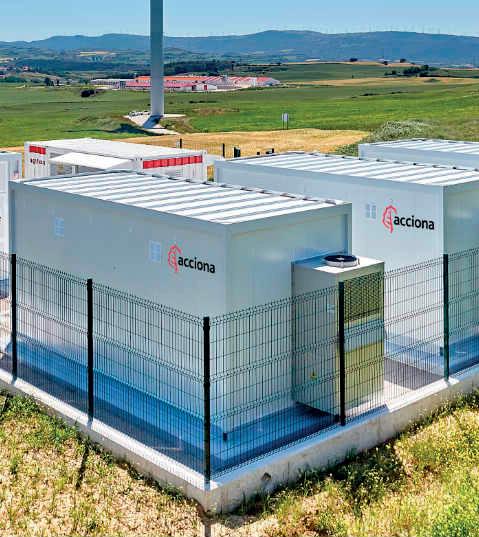

62 Environmental challenges and eco-social awareness 7
Storage facility of renewable energy.
Example of sustainable architecture.
Oxide of nitrogene
Carbon dioxide
Activities
7 Here are 10 suggestions on how you can reduce your plastic use. Discuss them in pairs and then put them in order, from the easiest to the most difficult to introduce in your daily life.
• Stop using plastic straws, even in restaurants.
• Use reusable shopping bags.
• Give up chewing gum. Chewing gum is made of a synthetic rubber (plastic) that is not biodegradable.
• Buy food like cereals, pasta and rice from bulk bins and fill a reusable bag or container.
• Use a reusable bottle or mug for your beverages, even when ordering from a takeaway.
• Use matches instead of disposable plastic lighters.
• Avoid buying frozen foods, because their packaging is mostly plastic that is not biodegradable.
• Ask your local grocer to take your plastic containers (for berries, tomatoes, etc.) back.
• Make freshly squeezed juice or eat fruit instead of buying juice in plastic bottles. It is healthier and better for the environment.
• Use a razor with replaceable blades instead of a disposable razor.
8 Explain in your own words what sustainable development is. Create your own logo and make a poster. Vote for the best three in the class.
9 Do the following activities contribute to sustainable development? If not, change the sentences to make sustainable alternatives.
a) Buying the new version of an electronic gadget every year.
b) Leaving the lights on in the classroom at the end of the class.
c) Reusing pieces of paper by writing on the side you have not already used.
d) Putting rubbish in the bin, including organic waste, paper and plastic containers.
e) Sleeping with the heating or air conditioning on at night.
f) Using energy-saving light bulbs, even though they are more expensive.
Task TIME-LAPSE AS EVIDENCE
Time-lapse is a technique employed in film and photography to represent different moments of an event that is not visible to our eyes because it elapses too slowly. This is the case with the consequences of global warming. This technique makes it possible to demonstrate the evidence that shows global warming and, in general, the impact of human activities on nature.
Google has created different time-lapses of places around the planet in order to see the effects of global warming. You can check them at: https:// earthengine.google.com/timelapse/.
10 Young people meet UN agents annually to work together on ambitious climate actions that push the world toward sustainability. Read the text and say if the sentences below are true or not.
Climate change has increased levels of uncertainty about our future. As its impacts intensify over time, one thing has become certain: we will leave the Earth to today’s children and young people, and to future generations, in a worse state.
The world is home to 1.8 billion young people between the ages of 10 to 24 —the largest generation of youth in history. Young people are increasingly aware of the challenges and risks presented by the climate crisis and of the opportunity to achieve sustainable development brought by a solution to climate change. Young people’s unprecedented mobilisation around the world shows the massive power they possess to hold decision-makers accountable. Their message is clear: the older generation has failed, and it is the young who will pay in full —with their very futures. Young people are not only victims of climate change. They are also valuable contributors to climate action. They are agents of change, entrepreneurs and innovators. Whether through education, science or technology, young people are scaling up their efforts and using their skills to accelerate climate action.
a) Young people are not interested in climate actions.
b) The older generations have failed, and the young are suffering from all their decisions.
c) Young people are agents of change, entrepreneurs and innovators.
d) Climate change does not affect future generations.
e) Young people are looking for new actions through education, science and technology.
A. Typ e the following place names into the search engine and describe what you observe at each of them
1 Lake Urmia, Iran.
2. Kilimanjaro, Tanzania.
3. Columbia Glacier, Alaska (USA).
B. W hat economic, social and environmental effects do you think are occurring in these locations?
C. I s it reasonable to deny the effects of global warming and other effects of some human activities on the environment?
D. D oes global warming affect all countries equally? Look at the map and explain what would happen if the Arctic Ocean were navigable throughout the whole year.
63 Environmental challenges and eco-social awareness
in your notebook V 7
Writing activities should be completed
➍ THE SUSTAINABLE DEVELOPMENT GOALS
The 2030 Agenda for Sustainable Development, adopted by a great number of United Nations Member States in 2015, provides a shared blueprint for peace and prosperity for people and the planet, now and into the future.
The Sustainable Development Goals (SDGs) are an urgent call for action by all countries – developed and developing – in a global partnership to be achieved in 2030. They recognise that ending poverty and other deprivations must go together with strategies that improve health and education, reduce inequality, spur economic growth and seek to take care of the climate and work to preserve our oceans and forests.
1 End poverty: increase access to resources and provide aid to communities most affected by conflict or natural disasters.
2 Zero hunger: ensure investment in the infrastructure and technology needed to improve agricultural productivity.
3 Health and well-being: reduce inequality and ensure good health for all people.
4 Quality education: promote inclusive, quality education so that all children complete primary and secondary education.
5 Gender equality: ensure equal rights, as well as universal access to reproductive health.
6 Clean water and sanitation: ensure universal access to safe drinking water and provide adequate sanitation facilities to maintain proper hygiene.
7 Affordable and clean energy: improve energy productivity by investing in clean energy sources.
8 Decent work and economic growth: stimulate sustainable economic growth by increasing productivity and types of innovation.
9 Industry, innovation, and infrastructure: reduce the digital divide and promote sustainable industries by increasing investment in research and innovation.

10 Reducing inequalities: improve market regulation and promoting migration and mobility of people.
11 Sustainable cities and communities: ensure access to safe housing and investing in public transport and urban management.
12 Responsible production and consumption: meet consumption needs by creating more efficient production chains and reducing food waste.
13 Climate action: adopt measures to reduce the risk of natural disasters and prevent the global average temperature from rising.
14 Underwater life: protect marine and coastal ecosystems from landbased pollution.
15 Life of terrestrial ecosystems: preserve natural habitats and biodiversity.
16 Peace, justice, and strong institutions: exchange ideas to find lasting solutions to conflicts and promote human rights.
17 Partnership to achieve the goals: promote cooperation and support international trade to achieve a universal system that benefits all.
➎ ENVIRONMENTAL PROBLEMS AND SDGS IN ANDALUSIA
In Andalusia, through the Institute of Statistics and Cartography, a System of Sustainable Development Indicators has been created for the 2030 Agenda. These indicators enable comparison with other regions of Spain and with other countries in the European Union, as well as being able to see its own evolution within its own territory.
An analysis carried out by several public and private institutions in 2021 on the degree to which the SDGs are being met in Andalusia revealed that in our autonomous community, fulfilment is at around 60 %.
DEGREE OF FULFILMENT IN ANDALUSIA
Higher level of achievement
3. Health and well-being
16. Peace, justice and solid institutions
8. Decent employment and economic growth
Lower level of achievement
13. Climate action
15. Life of terrestrial ecosystems
6. Clean water and sanitation
ENVIRONMENTAL PROBLEMS IN ANDALUSIA
Rise in emissions from industrial activities.
Dumping of waste and waste spills.
Unsustainable fishing methods.
Danger of leaks from nuclear graveyards.
Long periods of drought.
Poor conservation policy of forests and prevention of forest fires.
Illegal extraction of water from underground water wells.
64 Environmental challenges and eco-social awareness 7
Activities
11 Indicate which of the SDGs the following actions are concerned with:
a)
12 Use the vocabulary you have learned in this unit to guess what the following statements refer to.
a) It is a change in the Earth’s climate. This could be a change in the Earth’s usual temperature. Or it could be a change in when rain and snow usually fall on Earth.
b) It is a natural process that warms the Earth’s surface. When the sun’s energy reaches the Earth’s atmosphere, some of it is reflected back to space and the rest is absorbed and re-radiated by greenhouse gases.
c) It is the clearing of forest areas by cutting down the trees. It can be for the purpose of exploiting the land commercially. It might also occur accidentally when wildfires destroy large forest areas.
d) They aim to transform our world. They are a call to action to end poverty and inequality, protect the planet, and ensure that all people enjoy health, justice and prosperity.
e) They are a framework to describe limits to the impacts of human activities on the Earth system. Beyond these limits, the environment may not be able to self-regulate anymore.
13 Go to the website https://calculadora-carbono.climatehero. org and calculate your home’s carbon footprint. Then consider and decide which two of the actions proposed by the final report you could undertake in your daily life to reduce it. Do not forget to set the language of the test to English.
14 2 Listen to the audio and match each locality with its environmental problem.
Province Main environmental problem
a) Almería 1. It doubles the air pollution threshold
b) C ádiz 2. It triples the average quantity of microplastics on the seabed
c) C órdoba 3. Impact on biodiversity of the toxic chemicals in sun creams
d) Granada 4. High pollution due to port activity
e) Huelva 5. The traffic causes very poor air quality
f) Jaén 6. The second-worst city in the country for air quality
g) Málaga 7. Open-air toxic waste dump
h) Sevilla 8. Villanueva del Arzobispo is one of the most polluted towns
15 Read the text and summarise the information in a diagram:
The use of renewable energies in Andalusia increased between 2000 and 2020. Andalusia has a high potential of renewable energy resources distributed throughout the region and contributes 19.3 % of the energy consumed, 29.3 % of electricity and 10.1 % in biofuels for transport:
• Solar energy: Andalusia has a high number of sunshine hours. Our region has been a pioneer in the production of heat and electricity from solar energy.
• Biomass: This is mainly obtained from the cultivation of olive groves and related industries. In 2020, biomass contributed 50 % of the primary energy consumption from renewable sources in Andalusia.
• Marine energy: The technology is still in its infancy, but the marine currents in the Strait of Gibraltar, the Atlantic coast of Andalusia and the western coast of Almería offer great potential.
• Geothermal energy: There is a significant potential of low-temperature resources in and around the provincial capitals, particularly Granada, Seville and Cordoba, where the high population density makes its use more profitable in centralised air conditioning. However, there are no high-enthalpy resources in the region aimed at generating electricity.
• Hydro energy: There is exploitable mini hydro capacity (<10 MW) in the numerous small abandoned plants that could be modernised and automated.
Adapted text. Agencia Andaluza Energía
65 Environmental challenges and eco-social awareness
your notebook V 7
Writing activities should be completed in
Report offensive comments against women on social media 1. SDG 1
Buy second-hand clothing and sell yours if it is in a good condition 2. SDG 12 c) Install solar panels at home 3. SDG 2 d) Donate to food banks in your area 4. SDG 5 e) Participate in planting trees in reforesting projects 5. SDG 6 f) On you birthday, as well as asking for presents, ask your family to sponsor a child 6. SDG 11 g) Vote when you are able to 7. SDG 7 h) Collect the cold water that comes out of the shower while it is heating up and use it for washing or watering plants 8. SDG 3 i) Do not smoke and quit energy drinks 9. SDG 16 j) Use public transport when possible 10. SDG 15
b)
Grammar in geography and history
Talking about plans, predictions
We use different verb forms to talk about our plans for the future.
We use will to talk about spontaneous plans decided at the moment of speaking.
z Oops, I forgot to phone Marta! I’ll do it after dinner.
z There’s no milk. I’ll buy some when I go to the shops. We use going to to talk about plans decided before the moment of speaking.
z I’m going to phone Mum after dinner. I told her I'd call at 8 o’clock.
z I’m going to go to the supermarket after work. What do we need?
We usually use the present continuous when the plan is an arrangement –already confirmed with at least one other person and we know the time and place.
z I’m meeting Jane at 8 o’clock on Saturday.
z We’re having a party next Saturday. Would you like to come?
10 questions
1 When did the environment begin to get altered?
In the 18th century, with the Industrial Revolution, the population increased exponentially. New technology exploited the resources of the planet, which began to create problems of pollution, alteration on the Earth’s surface, and over-exploitation of natural resources.
2 What are the planetary boundaries?
They are a framework to describe limits to the impacts of human activities on the Earth system. Beyond these limits, the environment may not be able to self-regulate.
3 What gases create the greenhouse effect?
Carbon dioxide and methane retain the heat that the sun radiates onto the Earth’s surface, preventing it from escaping to outer space. This causes the warming of the planet’s surfaces.
4 What agreement was reached at the summit in Paris in 2015?
In this summit on climate change, they agreed to limit the increase in average world temperature to 1.5 °C.
5 Name three measures to achieve climate neutrality. Sustainable mobility through electric vehicles and improvement of public transport; policies to promote sustainable architecture and energy renovation; promoting education about responsible consumption.
Activities
1 Complete the sentences using will or the present continuous:
a) Climate models predict that Earth’s global average temperature (rise) an additional 4 °C (7.2 °F) during the 21st century.
b) Warmer temperatures (cause) (and (cause)) changes to other aspects of climate – such as rain, snow, and clouds.
c) A warmer average global temperature (cause) the water cycle to ‘speed up’ due to a higher rate of evaporation. More water vapor in the atmosphere (lead) to more precipitation.
d) However, changes in precipitation (not be) evenly distributed. Some locations (get) more, and others (see) less.
e) Arctic sea ice (melt) more rapidly than the Antarctic Sea ice. Melting ice may lead to changes in ocean circulation, too. Summer in the Arctic Ocean (be) ice-free by the end of the century.
2 Be going to is used to talk about plans and intentions, usually when the decision has already been made. Complete the following sentences:
a) Look at those clouds. It’s !
b) According to the evidence, we can confirm that the climate on Earth is
c) A big oil tanker sank yesterday. the activists because of the oil spills?
d) I am very tired of all the fake news. I’ the news today.
6 What does decarbonisation consist of?
It refers to all measures that reduce the carbon footprint, primarily greenhouse gas emissions, carbon dioxide (CO2) and methane (CH4), in order to reduce its impact on the climate.
7 What are the SDGs?
They are a series of goals that humanity must achieve by 2030 to improve the future both for all species on the planet and for the Earth system as a whole.
8 Name 3 SDGs related to caring for the environment. SDG 13, reduce the risk of natural disasters and prevent the rise of temperature; SDG 14, protect marine and coastal ecosystems from land-based pollution; SDG 15, preserve natural habitats and biodiversity.
9 Name 2 SDGs related to education. SDG 4, promote quality education for all children. SDG 5, ensure equal rights, as well as universal access to reproductive health.
10 To what extent has Andalusia achieved the SDGs?
An analysis carried out in 2021 states that our autonomous community has achieved around 60 % of the SDGs.
66 Environmental challenges and eco-social awareness 7 Writing activities should be completed in your notebook V
final task
Preparing an interview
1
WHAT TO SOLVE?
The interviews that we can find in magazines are a huge help in learning new information, with personal opin- ions and photographs. The dissemination of the SDGs through interviews will enhance awareness of them.
2
HOW TO DO IT?
Since their origin in seventeenth-century Europe, magazines were a medium of communication for society that was flexible and attractive due to the way in which they dealt with different topics. With the coming of the internet and digital resources, magazines have become more dynamic and interactive than in the past. In interviews, there can be different sections to shine the spotlight on any question in more detail. Carrying out an interview requires preparatory work, which you will do in groups. The app Hello History (https://www.hellohistory.ai) enables you to interact even with famous people who are no longer alive.
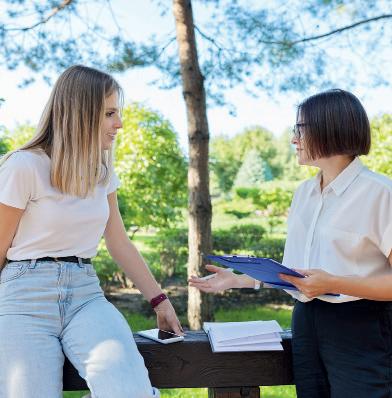
SHARE YOUR EXPERIENCE
We will choose from one of the following characters related to the SDGs we have seen:
• Prehistoric man.
• Mother Teresa of Calcutta (SDG 1, 2-6)
• A bacteria (SDG 3)
• Marie Curie (SDG 4)
• Simone de Beauvoir (SDG 5)
• Nikola Tesla (SDG 7)
• Karl Marx (SDG 8)
• Thomas Edison (SDG 9)
• Martin Luther King Jr. (SDG 10)
• Carl Linnaeus (SDG 11)
• Father Christmas (SDG 12)
• Paul McCartney (SDG 13)
• Charles Darwin (SDG 14,15)
• Gandhi (SDG 16)
• Nelson Mandela (SDG 17)
• Jean Piaget (SDG 4)
Using the Wh-questions structure, compose different questions to obtain information, and then conduct the interview. Then, complete the following information file:
• Brief biographical notes: date and place of birth, occupation.
• Why is the character relevant?
• Questions and answers.
• Answers that are noteworthy. However, if you prefer, you can also write your questions for any of these characters, and then answer them as you imagine they would have done.
The different interviews can be shared on the school’s social media sites and in the corridors. You can invite your schoolmates to show whether they like them or not. 3
Writing activities should be completed in your notebook
67 Environmental challenges and eco-social awareness
V 7
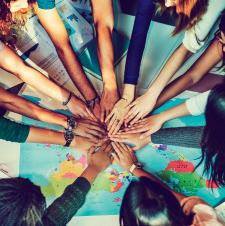
8 Institutions and policies for equality and social justice
➊ AN UNEQUAL WORLD
We live in an unequal world, which is the result of economic differences and not knowing how to integrate the diversities of humankind.
The economic differences have their causes in history: Europe, the United States and some Asian countries have exerted economic, military and cultural hegemony, subjugating the other peoples on the planet.
The ‘impoverished countries’ are rich in natural resources, but their exploitation is controlled by countries with highly developed economies. The population of the impoverished countries live in poverty, suffer epidemics, endure starvation, wars and emigration. In the developed world, wealth distribution is unequal. The ‘fourth world’ is the term used to describe all those populations in situations of marginality and lacking protection. These are populations that live under the poverty threshold in situations of vulnerability. Among the most affected groups are immigrants and elderly people with small pensions.
The UN 2030 Agenda sets out goals and actions to eradicate extreme poverty, hunger, inequalities, and to protect the environment.
Social progress is made with the effort of civil society through political organisations, unions, associations and neighbourhood movements.
➋ HUMAN RIGHTS AS A RESPONSE
The UN came into being in 1945 after the horrors of the Second World War to safeguard the values of peace, justice, respect, human rights, tolerance and solidarity. In 1948, the General Assembly proclaimed the Universal Declaration of Human Rights, establishing the fundamental rights that must be protected in every part of the world. Human rights have come to be organised into generations of rights.
World wealth compared by region
In 2021, the average wealth of North America represented
% of the average world income
International institutions
Main associations and nongovernmental organisations (NGOs)
Source: Report on global inequality, 2022.
Defence of human rights
• The United Nations (UN).
• The International Court of Justice.
• The International Criminal Court.
• The European Court of Human Rights.
• Amnesty International denounces violations of human rights.
• Greenpeace, in defence of the environment.
• International Committee of the Red Cross, in defence of human rights and promotor of International Human Law (IHL).
• Doctors Without Borders provides humanitarian medical care.
Rights of a political and civil kind: to self-determination, to real equality, prohibition of torture… 2nd
Defend the value of equality above other ideas. They aspire to achieve a worthy standard of living for all people.
3rd generation
th and 21st centuries
Seek to build a world governed by peaceful relations and effective cooperation. Solidarity as the supreme value.
Rights of an economic, cultural and social nature: to
Principal rights: to peace, to development, to a clean environment.
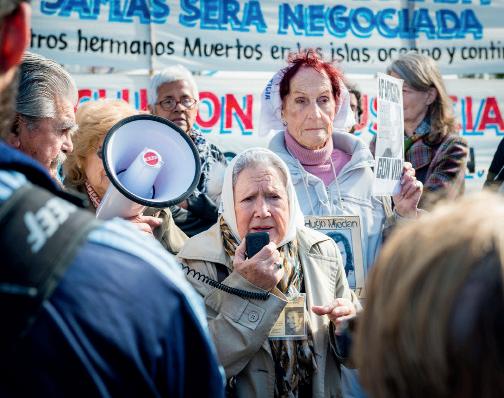
The Mothers of Plaza de Mayo began a struggle to shed light on what had happened to the people who had disappeared during the Argentine dictatorship of Videla from the end of the 1970s to the early 1980s.
68 Institutions and policies for equality and social justice
Generations of human rights Stage Dates Fundamental value Most significant rights Declaration 10/12/1948
Defend the value of freedom as a basic concept.
generation 19 th century - 1950
to
work, to suitable housing,
health and to education.
20
East Asia Europe North America 50 % 0 % 100 % 150 % 200 % 250 % 300 % 350 % Russia and Central Asia Middle East and North Africa Latin America Southeast Asia Sub-Saharan Africa 17 % 40 % 51 % 54 % 54 % 142 % 230 % 390 %
Total average global wealth
390
Activities
1 2 Listen to the audio recording and complete the text. Then, answer the questions.
Very often, in the that happen in poor countries, human are not respected. This is especially the case for those who are the most defenceless, like children. There are around 300,000 child in the world today who carry out different tasks, not just carrying a , but also cooking, taking messages or doing sex work, especially in the case of According to different international organisations, there are 19 countries where children continue to be recruited as soldiers. These include Afghanistan, , India, Libya, Sudan and . In these countries, children are often seen as a and obedient military force who are easy to replace and who do not think about the serious consequences of acts of war. At present, more than countries, among them Spain, have signed a protocol to end the recruitment of and defend their rights.
a) What are child soldiers used for in wars? Why can they be especially useful?
b) Search online and then list other countries that recruit child soldiers for their armies.
2 Write a definition for the following institutions:
a) UNHCR.
b) Red Cross.
c) Amnesty International.
d) Doctors Without Borders.
e) Greenpeace.
f) UNICEF.
3 Choose the correct options and, in your notebook, write down this extract from The Greenpeace Framework, a tenyear mission statement.
Every day we are bombarded by stories that are carefully crafted to support the broken system and the interests of self-educated/interested/critical elites. They are designed to tell us what to think, promote a range of mindsets, and a way of thinking – ultimately – about what is and is not possible.
Greenpeace must promote/control/challenge these dominant mindsets, the myths and stories that tell people there is only one world possible – the one in which we live sustainably/selfishly/unselfishly, separate from nature, using the Earth’s limited resources/ income/population for our relentless ‘needs’.
Our mission should be to promote/challenge/prevent a new perspective and shift in mindsets, one that is rooted in stories that help us: valuing people and communities near and far; understanding that we came from/are separate from/are part of nature and that we each hold a stake in its future; measuring our success according to our relationships and not our possessions; understanding that security depends upon a healthy environment and a just, unequal/equitable/unfair society rather than force and surveillance; understanding that people, not environmental groups/endangered wildlife/ corporations and self-interested elites, should be at the heart of governance and public life; seeing that the world is getting better, because people are working together/ consuming more/doing nothing to make it so; and understanding that the economy must work within the environmental limits of the government/planet/ business community
Task THE REALITY OF REFUGEES
Millions of people all over the world are forced to become refugees. There are many causes, and the consequences are drastic in most cases. Here are some personal stories.
Lina (43 years old) tried everything possible not to leave Syria. First she moved to a more central area of Damascus, where she lived until the bombs started to explode close to her home and the school of her two children. At the end of 2014 they managed to reach Madrid, but still dream of returning to their country.
Before fleeing, Zabioullah (22 years old) and his family barely managed to survive in an environment of repression and war. Faced with the threat of being forced to join the ranks of the Taliban, he chose to make his way out of Afghanistan on foot. He reached Spain hidden in a lorry.
Olga (28 years old) lived the normal life of any young person who had just started their first job. But when the Russians invaded Donetsk, she fled to the neighbouring locality further from the battle lines. Unable to find the means to survive there, she escaped to Spain, where she met up with her brother.
A. Loo k up the definition of refugee and read the personal accounts. Discuss in pairs where they come from and the reasons why they have had to flee their country of origin.
B. In groups of 3 to 5 members, search for information on the role played by the organisations UNHCR (United Nations High Commissioner for Refugees) and CEAR (Spanish Commission for Aid to Refugees). What solutions do they offer for these people? Is there a local organisation devoted to helping refugees and what type of aid do they provide?
69 Institutions and policies for equality and social justice Writing activities should be completed in your notebook V 8
➌ TOWARDS REAL EQUALITY BETWEEN WOMEN AND MEN
In the 18th century, women began to organise and fight to defend their rights. The struggle for equality is still being fought today. The successive waves or stages of the feminist∞ movement show us the progress in achieving women’s rights:
The Waves of Feminism
Demands Spain
1. The Suffragette Movement: 18 th century to 1950
2. Second wave of feminism: 1950-1980
3. Feminism against oppression: 1990-2010
4. Feminism in the present: 2010-today
Demanded the legal equality of men and women, and the right to vote.
The patriarchal∞ society and the traditional family are questioned. Simone de Beauvoir played a prominent role.
Oppression has different strata. The movement became divided. In the USA, Angela Davis was a notable figure.
The struggle against gender-based violence and unequal pay, and recognition of the role of women in history and culture.
International organisations are pushing policies in favour of equality of opportunity between women and men, as well as working to eradicate gender-based violence. The Istanbul Convention of 2011 was a vital step in the prevention of, and struggle against, violence against women.
In Spain, the winning of rights has been progressive. In parallel with the legislative evolution, institutions have been created for the protection of women’s rights. Andalusian local councils have promoted a network of Local Women’s Information Centres which people can go to for guidance, and psychological and legal support.
➍ TOWARDS DIVERSITY AND INTERCULTURALISM
Diversity is an asset for society in the present day. The UN established the World Day for Cultural Diversity for Dialogue and Development (21st May) to stress the need for interculturalism as the basis for peaceful co-existence and the driver of sustainable development.
Migrants are an important factor in favour of interculturalism. In the present day, millions of people live in places far from where they were born, and there they become agents of cultural exchange.
Andalusia is a special place in terms of interculturalism, due to its richness and variety. We must work to eradicate speech based on hate toward those we consider to be different.
Sexual and gender diversity refers to the diversity of sexual and gender orientations, identities, and expressions, without people having to face forms of marginalisation, discrimination, or violence.
Historically, sexual diversity has been criminalised and even considered a mental illness. In many parts of the world, persecution due to sex and gender involves a variety of punishments that even go as far as the death penalty in some countries. In order to help give visibility to sexual diversity, recognising and protecting it in law, commemorative days have been established. In the year 2005, Spain became the third country in the world to legalise marriage between same-sex people.
Clara Campoamor was the most prominent activist. In the Second Republic they achieved many rights for women.
The Democratic Women’s Movement began.
The feminist movement expanded and the organisations became stronger.
The #MeToo movement reaches Spain. Greater awareness against sexual assault and harassment, and gender-based violence.
VOCABULARY
Feminism: this is the belief in the social, economic, and political equality of the sexes.
Patriarchy: a society in which the oldest male is the leader of the family, or a society controlled by men in which they use their power to their own advantage.

The legendary activist Angela Davis. Prominent feminist and anti-racist, in her youth she was connected to the Black Panthers, a party that emerged in the 1960s in the United States whose aim was to defend the rights of the African-American people.

Despite the progress made, the feminist movement is still vitally important. The struggle for real equality has two notable milestones, on every 25th November and every 8th March, when hundreds of feminist groups come together.
70 Institutions and policies for equality and social justice 8
Activities
4 2 Listen to the audio recording and complete the following statements about the inequality between men and women.
While the situation of women varies from one part of the world to another, there is a common element: women suffer discrimination everywhere. Here are some important facts:
• in three of the world’s illiterate adults are women.
• Only of women continue to receive their salary when they are on maternity leave.
• million girls do not go to school.
• Women carry out times more unpaid activities in the house than men.
• Half of all women in developing countries marry before the age of
• Women represent of the deputies in the parliaments of the world.
• For every €1 men earn, women earn
5 Find out who the suffragettes were and write down the name of one of the most important.
6 Interview an elderly lady from your neighbourhood and write a report explaining the differences that she had regarding rights compared to men when she was young, and include aspects such as: the type of clothes they used to wear, their schedule, housework, the types of jobs they could get, etcetera.
Task THE ISTANBUL CONVENTION
7 Many women, both in the past and the present, have stood out thanks to their activism in the fight for equality. Match the two columns to get to know more about them.
a) Lady Gaga
b) Beyoncé
c) Emma Watson
d) Emmeline Pankhurst
e) Simone de Beauvoir
f) Angela Davis
g) Angelina Jolie
1. She has been a feminist icon since she starred as the intelligent and outspoken Hermione Granger.
2. The Academy Award winner is as noted for her blockbuster films as she is for her philanthropic work.
3. She is known around the world for being an outspoken political activist, writer and social theorist. She wrote The Second Sex in 1949.
4. The political activist was a key leader in the Black Power movement. Her role in political protests has been deemed controversial.
5. Actor, singer and LGBTQ+ icon, she has been a proud feminist. She has also spent her career advocating for women's rights.
6. She founded the Women's Social and Political Union (WSPU) in 1903, an organisation that she opened exclusively for women with the motto: 'Deeds not words.'
7. She rose to fame with her girl group Destiny’s Child with hit songs such as ‘Independent Women’, ‘Survivor’, ‘Say My Name’ and ‘Girls’.
Preamble
The member States of the Council of and the other signatories hereto, recognising that: The realisation of de jure and de facto equality between women and men is a key element in the of violence against women.
against women is a manifestation of historically unequal power relations between and men, which have led to domination over, and against, women by men and to the prevention of the full advancement of women.
The structural nature of violence against women is -based violence.
A.
Complete the text with the correct words: domestic, children, Europe, mutilation, discrimination, family, prevention, violence, rape, marriage, women, armed, gender, affects.
Women and girls are often exposed to serious forms of violence such as violence, sexual harassment, rape, forced , crimes committed in the name of so-called “honour”, and genital , which constitute a serious violation of the human rights of women and girls. The ongoing human rights violations during conflicts that affect the civilian population, especially women in the form of widespread or systematic Domestic violence women disproportionately, and that men may also be victims of domestic violence. are victims of domestic violence, including as witnesses of violence in the Adapted from: Preamble to the Istanbul Convention, 2011
B.
C.
In your notebook, name the main themes set out by the Istanbul Convention in the preamble.
Do you think that the proposal of the Istanbul Convention is an effective response to the reality of our society?
71 Institutions and policies for equality and social justice
should be completed in your notebook V 8
Writing activities
➎ SCIENTIFIC AND TECHNOLOGICAL PROGRESS: OPPORTUNITIES
AND RISKS
Scientific and technological development has accelerated since the Industrial Revolution, particularly in the 21 st century. Investment in research, development and innovation (R&D&i) is essential but has created differences between developed countries and those that are developing. Technologies have transformed daily life, making many tasks easier. But they have brought about a digital divide between those who are capable of adapting and those who are not. The lack of access to technology causes growing inequality between states and between people. As SDG 9 states, it is vital to make access to technologies universal and affordable.
Some types of cyber-bullying
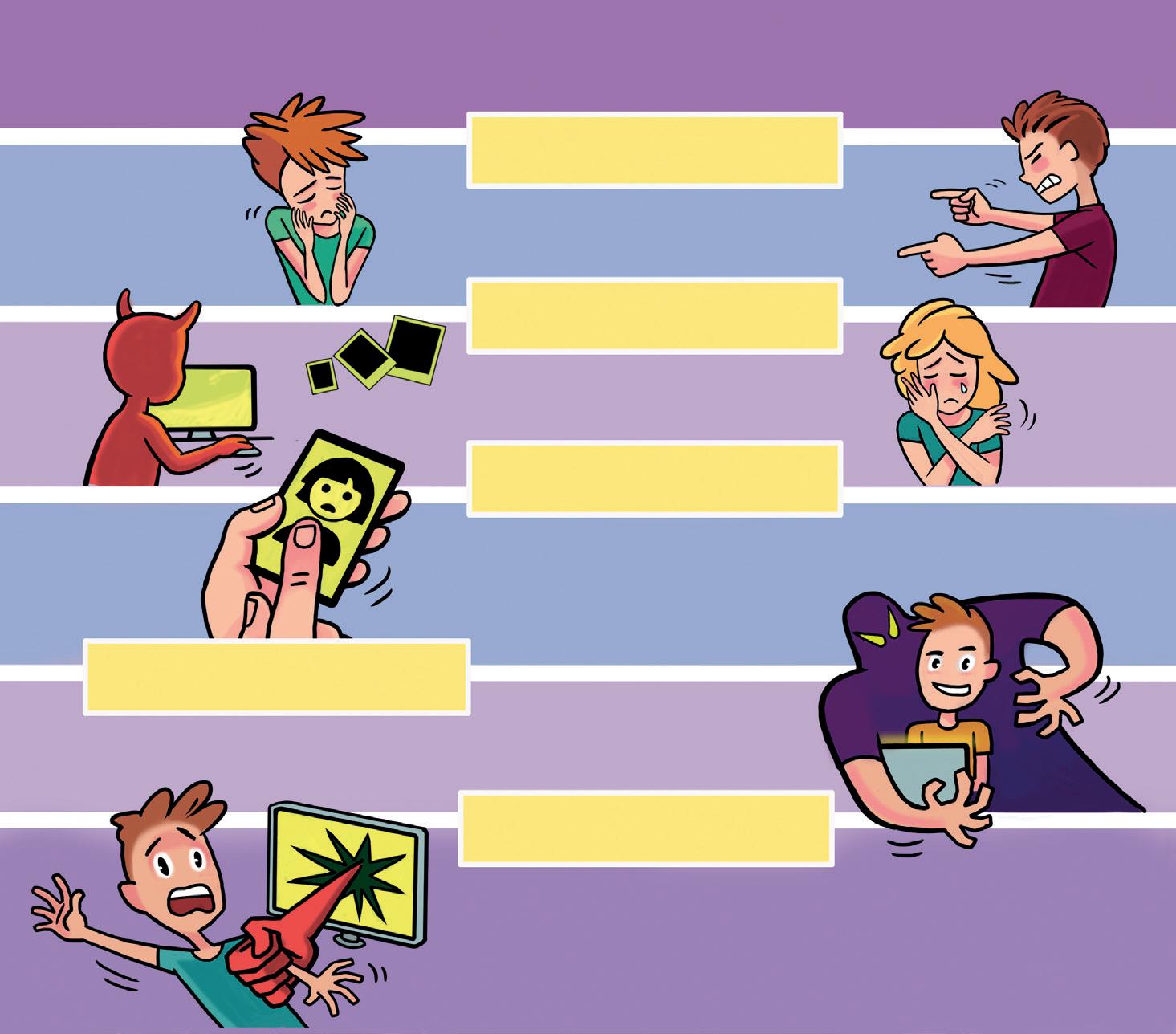
Harassment: denigration, constant threats and insults against a person.
Sextortion: threatening a person with sharing intimate images of them without their consent.
Stalking: following a person obsessively.
Grooming: the luring of minors by paedophiles through deception.
Artificial Intelligence (AI) imitates human intelligence to carry out certain tasks and solve problems. A great deal of controversy is being generated around them. As with other issues, we need harmonious development between science, technology and ethics. It is essential that the benefits of scientific progress and its applications can be enjoyed by all people as a guarantor of dignified life. Social media is a separate sphere with associated risks. The use of smartphones has led to the need for laws to deal with the situation of dependence on these technologies and the expansion of the problem of cyberbullying.
➏ ANDALUSIA IN THE 21ST CENTURY. A DIVERSE AND MULTICULTURAL COMMUNITY
The Andalusia of the twenty-first century is a space where different communities co-exist, strengthening its multicultural character. The gypsy people have maintained their presence, conserving their essence.
Andalusia, situated on the southern border of the European Union, has become a target region for immigration. People arrive here from Africa and South America, seeking a better life.
The absence of workers for carrying out some economic activities has heightened the phenomenon of labour immigration. In addition, the good climate attracts retired people to settle from central and northern Europe, which is called tourist immigration.
Co-existence between different communities and nationalities in Andalusia involves addressing and building a model based on respecting diversity. It is essential to prevent xenophobic attitudes and behaviour.
It is important to continue the progress in politics that generate equality of opportunities between women and men and between the different sectors that make up the region.
Andalusia is a society of solidarity. There are many voluntary associations and NGOs that work daily in building the society of the future.
Bashing website: website created to ridicule a person publicly.
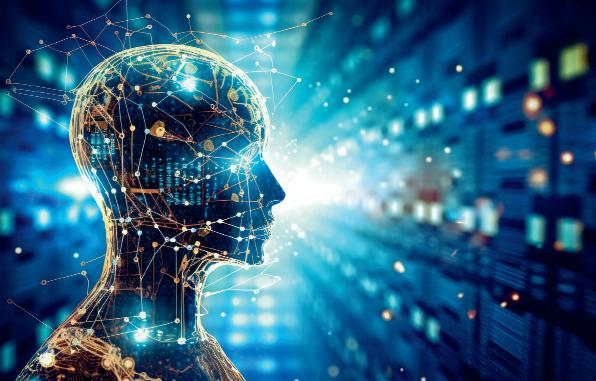
Artificial intelligence (AI) is currently revolutionising many spheres of human life.

Social media provides an excellent means of communication. But it also brings risks. They are a medium that is frequently used for hate speech, marginalisation and cyber-bullying.
72 Institutions and policies for equality and social justice 8
Source: Metro.
Activities
8 Match each term with its definition.
a) Social exclusion
b) Harassment
1. Similar to outing, but also with deception. Once the bully has gained their target’s trust, they maliciously share the victim’s secrets and private information with others.
2. Combination of the words ‘Facebook’ and ‘rape’. It occurs when a bully gains control of someone’s social media account and posts content to humiliate or embarrass the victim.
c) Outing or doxing
d) Trickery
3. The act of intentionally leaving someone out. A child might be excluded from a group, party or conversations that everyone else is included in.
4. The act of publicly revealing sensitive or personal information about someone, such as sensitive photos or private messages without their consent to cause them harm or humiliation.
e) Cyberstalking
5. Intentionally trying to incite negative reactions by posting inflammatory or attacking comments online.
f) Fraping
g) Trolling
6. Illegal behaviour towards a person that causes mental or emotional suffering, which includes repeated unwanted contacts, insults, threats, touching, or offensive language.
7. The use of the internet to make someone afraid or worried about their safety. For example, making threats via message to demand favours or tracking a person online.
9 2 Listen to the audio recording and complete the text with the missing words.
Robots will be smarter than humans by 2029
The Director of of an important technology company said will be more intelligent than humans by 2029. He is one of the world's leading experts on artificial (AI). The director believes computers will be able to learn from experiences, just like . He also thinks they will be able to tell jokes and , and even flirt. The is a lot sooner than many people thought. The scientist said that in 1999, many AI experts explained it would be hundreds of years before a was more intelligent than a human. He joked that many years ago, people thought he was a little for predicting computers would be as intelligent as humans. His thinking has stayed the same but everyone else has changed the way they think. ‘My views are not radical anymore. It’s the rest of the world that’s its view’.
Adapted text: www.breakingnewsenglish.com
10 Match the following words from the article to their synonyms.
a)
b)
c)
e)
f)
11 Intercultural is a term that we use to refer to today’s society. It involves two or more cultures, but it is not always used correctly. Complete the text with the following words to learn more about it: cross-cultural, interactions, ethnic, multicultural, norm, comparison, exchange, respect, intercultural. refers to a society that contains several cultural or groups. People live alongside one another, but each cultural group does not necessarily have engaging with each other. concerns the of different cultures. The differences are understood and acknowledged. One culture is often considered the describes communities in which there is a deep understanding and for all cultures. There is a mutual of ideas and cultural norms and the development of deep relationships.
12 Search the internet for an NGO established in Andalusia. Research its work and note down in your notebook what actions it carries out.
13 In this word search, find 8 terms from the vocabulary we have studied in this unit:
73 Institutions and policies for equality and social justice Writing activities should be completed in your notebook V 8
mad 1. more intelligent
strong 2. leading
forecast 3. experiences
to 4. prediction
d) pointed
smarter 5. powerful
way of think-ing 6. crazy
events 7. thinking
top 8. view
people 9. highlighted
opinions 10. the public
g)
h)
i)
j)
A H T B I R T H S T V H D N Y A P A T R I A R C H Y B A G D A B E A X H E S T N D N E R C L G B T Q I Y E O I O F L E D T E N L E T S I S T R E R E F U G E E S H T T E H U M A N R I G H T S A R C L W I I M P I N G G R S I H I O W B N U E S A S P I B N T E L L B I E A T R S N U O Y C S E A S S R C L U A T L U M E R N I H M N E R B I O C Y B E R B U L L Y N G O G W I M M B Y E L U M V U N Y
Grammar in geography and history
First conditional
The first conditional is used to talk about things which might happen in the future. This describes possible things, which could easily come true.
If + present simple, will + infinitive
z If you elect me as president, I will provide you with new social policies.
z If you vote for me, I will meet with the president to solve traffic problems.
If the condition is negative, we use if not/unless
z Traffic problems won’t be solved unless you vote for me.
z If we don't vote, we will not be represented in democracy.
10 questions
1 What does the term ‘fourth world’ mean?
It encompasses all situations where a population is marginalised and unprotected in the developed world. Among the most affected groups are immigrants and elderly people with meagre pensions.
2 What is the 2030 Agenda?
It is a collection of goals that the United Nations has set to be reached by the year 2030. These are the 17 Sustainable Development Goals.
3 How are human rights classified?
They have been organised into generations of rights: the first generation rights are civil and political; the second are economic, social and cultural; and the third are rights of solidarity, which expand and update the human rights recognised in the Universal Declaration.
4 What international institutions defend human rights?
The United Nations (UN); the International Court of Justice, the main judicial organ of the UN; the International Criminal Court; and in the European framework, the European Court of Human Rights.
6 Which two days are important in the fight for equality between women and men?
25th November, International Day for the Elimination of Violence against Women; and 8th March, International Women’s Day.
Activities
1 Make the first conditional with these sentences.
a) If we (defend) our rights in a totalitarian regime, we (go) to prison.
b) We (not get along) with other cultures unless we (try) to understand one another.
c) I (live) in New York if I (pass) my exams to work for the UN. d) You (can) join UNICEF if you (want) to help children.
2 Make questions with the following sentences using the first conditional and answer them.
E.g. If you live in a republic you will have a monarch.
Will you have a monarch if you live in a republic? No, you won’t. In a republic you will have a president.
a) If you have sponsors you will form a political party.
b) You will be arrested if you attend a demonstration in a dictatorship.
c) If you live in China you will vote for the Communist Party.
d) The Blue Helmets will defend a population if a government doesn’t respect human rights.

5 How many stages is the feminist movement divided into?
Into four. In the first, they demanded legal equality with men and the vote, and the suffragette movement was prominent. In the second, the patriarchy and the traditional family were called into question. In the third, the sex-gender system was questioned. And currently most focus is given to sexual assault and aggression.
7 What other diversity groups suffer discrimination? Migrants and the LGBTQI+ community.
8 What risks does technological development bring?
The lack of access to technological and digital innovations causes a gulf of inequality between states (the digital divide) and between groups that have not mastered new technology, such as the elderly.
9 What is interculturalism?
Intercultural describes communities with more than one culture in which there is a deep understanding and respect for all cultures. There is a mutual exchange of ideas and cultural norms and the development of deep relationships.
10 Why can we state that Andalusia is a society of solidarity?
Due to the high level of volunteer work that is carried out through associations, NGOs, and other forms of organisation, working daily to build the society of the future.
74 Institutions and policies for equality and social justice 8
should be completed in your notebook V
Writing activities
Slums in Hyderabad (India).
A workshop about inequalities
1
WHAT TO SOLVE?
In groups, you are going to analyse a situation of injustice or inequality that exists around us, and study it further in a workshop. You are going to find out all you can about it, analyse it, and propose solutions. To prepare the work, you must first carry out some prior activities.
2
HOW TO DO IT?
Using a colour post-it, each student shall write down a situation of injustice or inequality. When you show it to your classmates, explain why you have chosen it.
Between the whole class together, choose one situation and gather information to explain:
• What is it?
• What are its causes?
• What are its consequences?
Once you have completed step 1, in groups, prepare a digital presentation in which you explain the different aspects of the situation you have chosen and propose work strategies to rectify it.
When you have finished the presentations, the class should reflect on the reality they have analysed. You can use some of the following expressions:
• I was (not) aware of…
• Now, I understand that….
• I realise the cause of this situation is…
• For me, the worst consequence is…
• I think the best strategy is…
3
SHARE YOUR EXPERIENCE

Share your presentations in class and on school networks, to make your concerns known and show what actions you think could be carried out to improve the situation.
75 Institutions and policies for equality and social justice Writing activities should be completed in your notebook V 8 final task
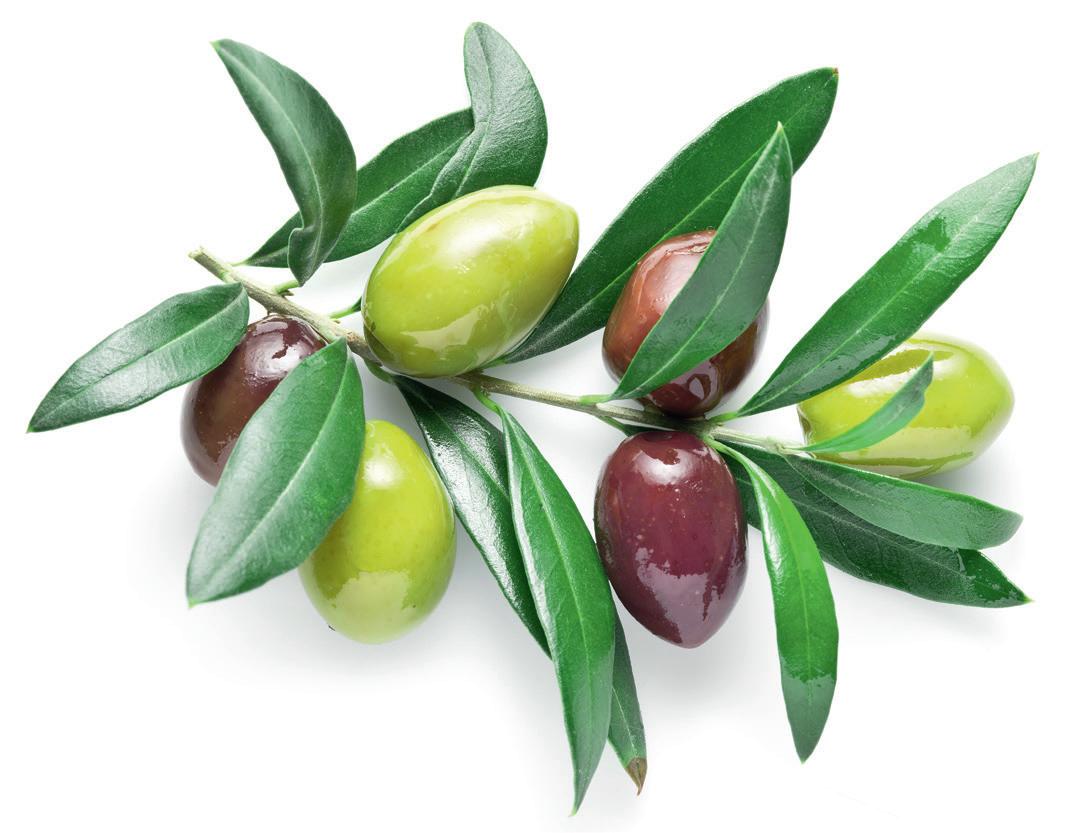
3 ISBN 978-84-9189-5633 9 788491 895633
GEOGRAPHY & HISTORY






















